
Namibia chapter twenty-four
Etosha National Park and the end of the road.
I wake up in the middle of the night to use the loo. Since I’m up I decide to check on the waterhole. I put on my jacket, hat, and scarf and step out into the night.
I’m the only one out. Three giraffe stand in a row off to the side. They glance over as I approach. Assured I pose no threat, they turn their attention back to the waterhole and I sit and watch as they appear to assess the safety of the situation.

Once satisfied they make their way slowly to the water. I can hear their hooves on clatter on the rocky terrain. They move slowly, cautiously alert to their surroundings and creatures that may lurk in the dark.
At the waterhole they take their time. One giraffe seems to remain vigilant as the others splay their legs so that their mouths can reach the water to drink, taking turns to make sure they all get their fill.
Sated they stand and turn towards the west. I watch and then listen as they make their way back into the bush. Their lithe forms disappear into the darkness and then all is silent.
I sit and wait in hopes of seeing more. The minutes tick by. As I’m about to head back to bed I hear the crunching of feet against stone to my right. I wait.
A black rhinoceros emerges from the dark, moving steadily towards the waterhole. It stops to drink before me before walking along the perimeter of the hole, showing off its muscular form. I watch as it kicks dirt with its hind legs as if preparing a spot. The rhino then defecates into the spot and kicks more dirt over the spot.
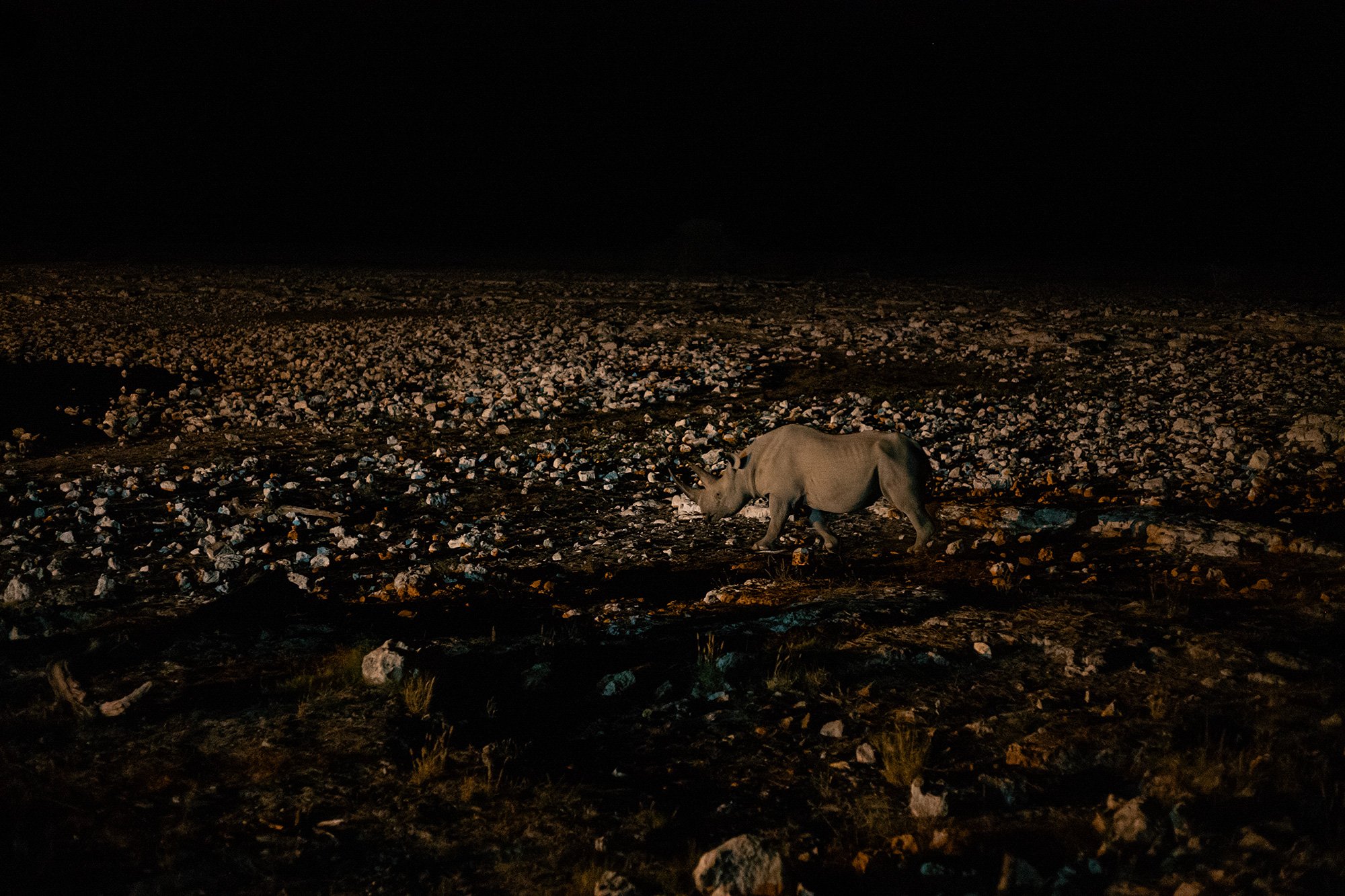
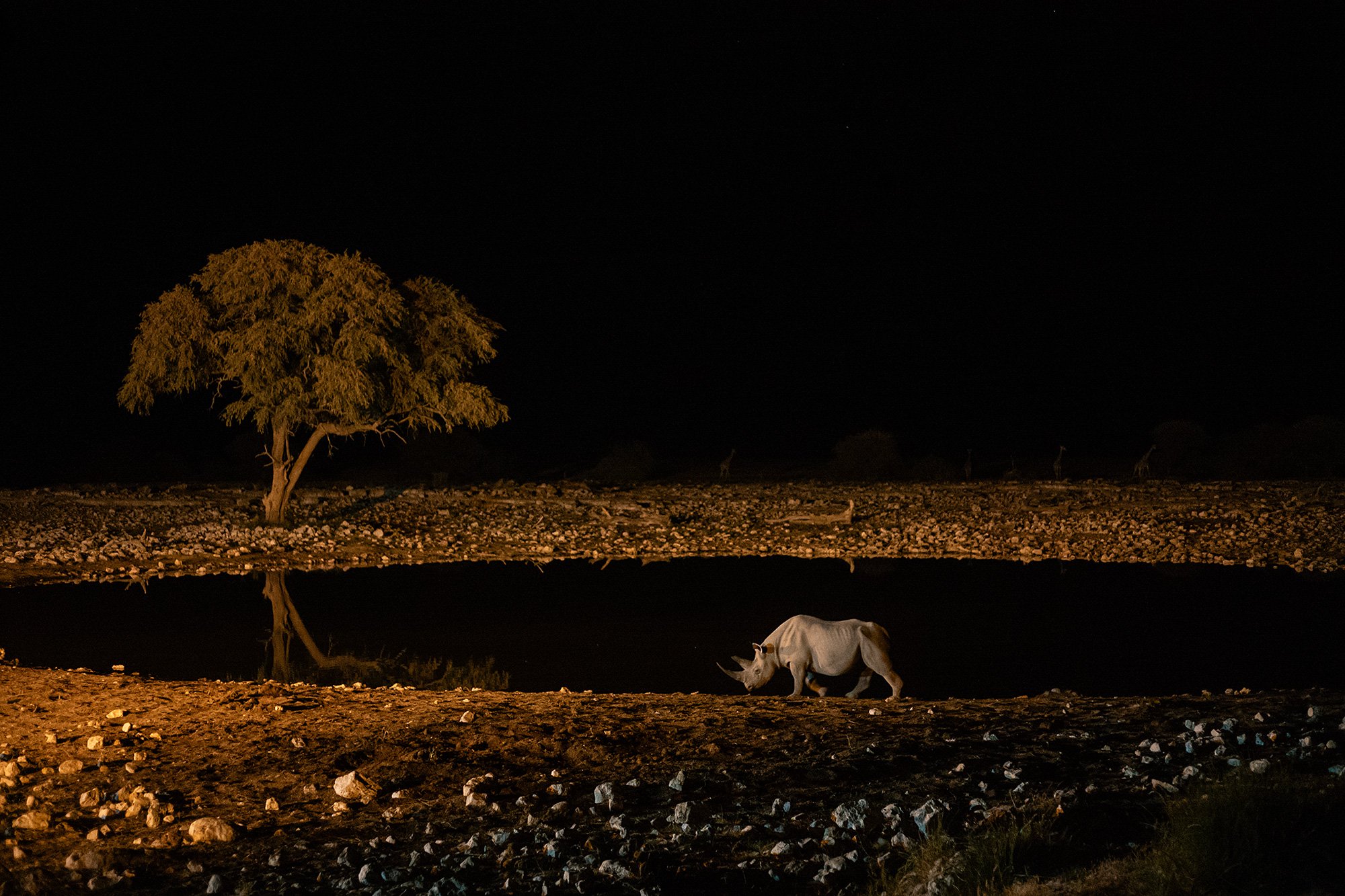
As the rhino makes its way around the hole I hear sounds in the distance. A clattering of hooves suggest more than one animal approaches. I strain to see through the night, but don’t have to wait long before a large number of giraffe emerge on the opposite side of the waterhole. The rhino seems uninterested; the giraffe are unperturbed.

I walk around the perimeter of the waterhole for a better view and perch on the back of a bench for a better view. The giraffe and rhino drink and then wander off back into the bush. I listen until I can no longer hear the sound of their footsteps. I’ve spent the better part of an hour by the waterhole and force myself back to bed. I have a long day ahead of me.
•
In the morning I head back to the waterhole before taking breakfast at the restaurant. A lone giraffe wanders across the plains in the distance. Birds flit by. I sit beside a man who points out two lions far off in the distance. He lends me a pair of binoculars and through them I spot a large male and female lying down on the plain. The female looks to be asleep.
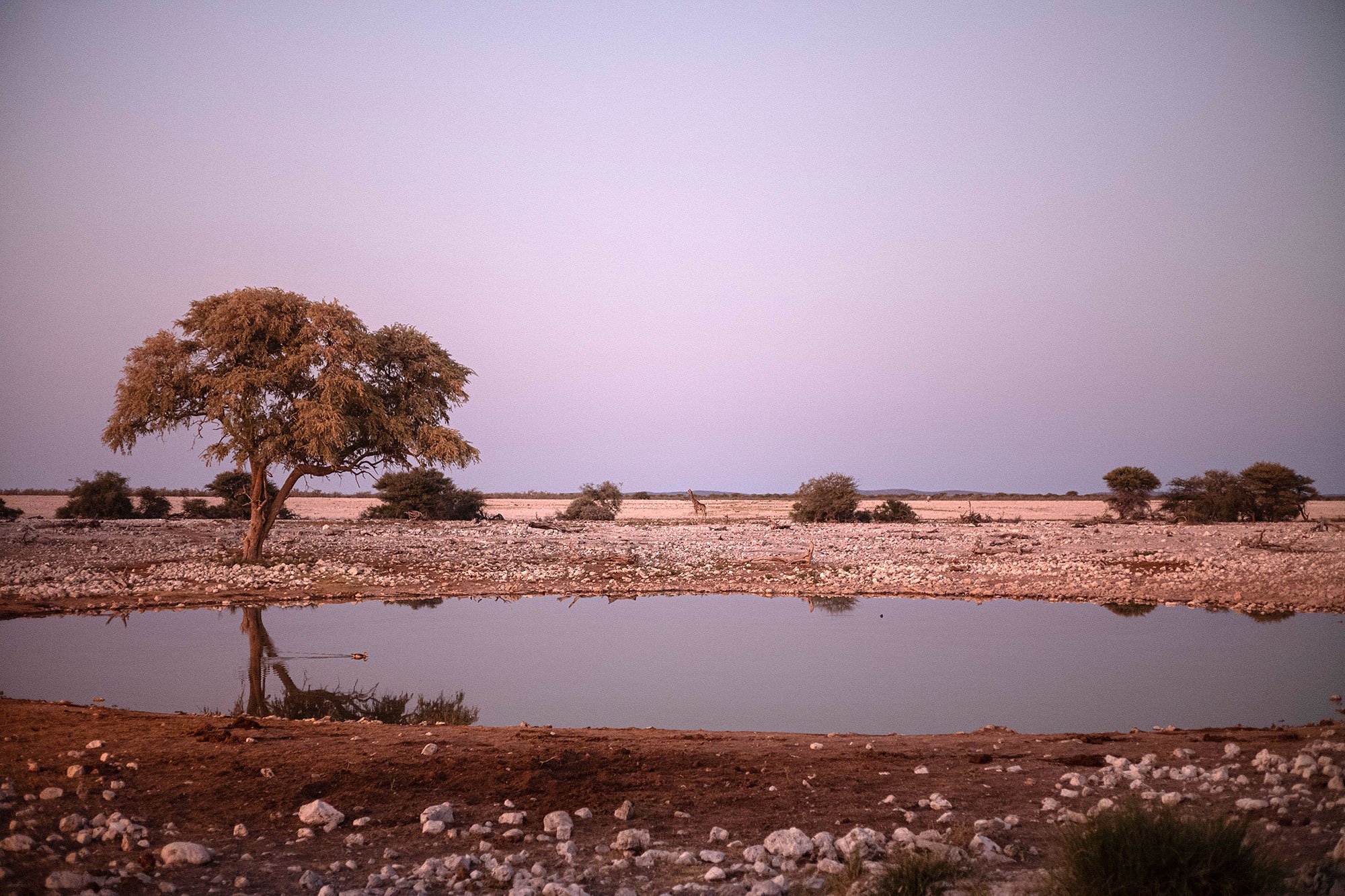
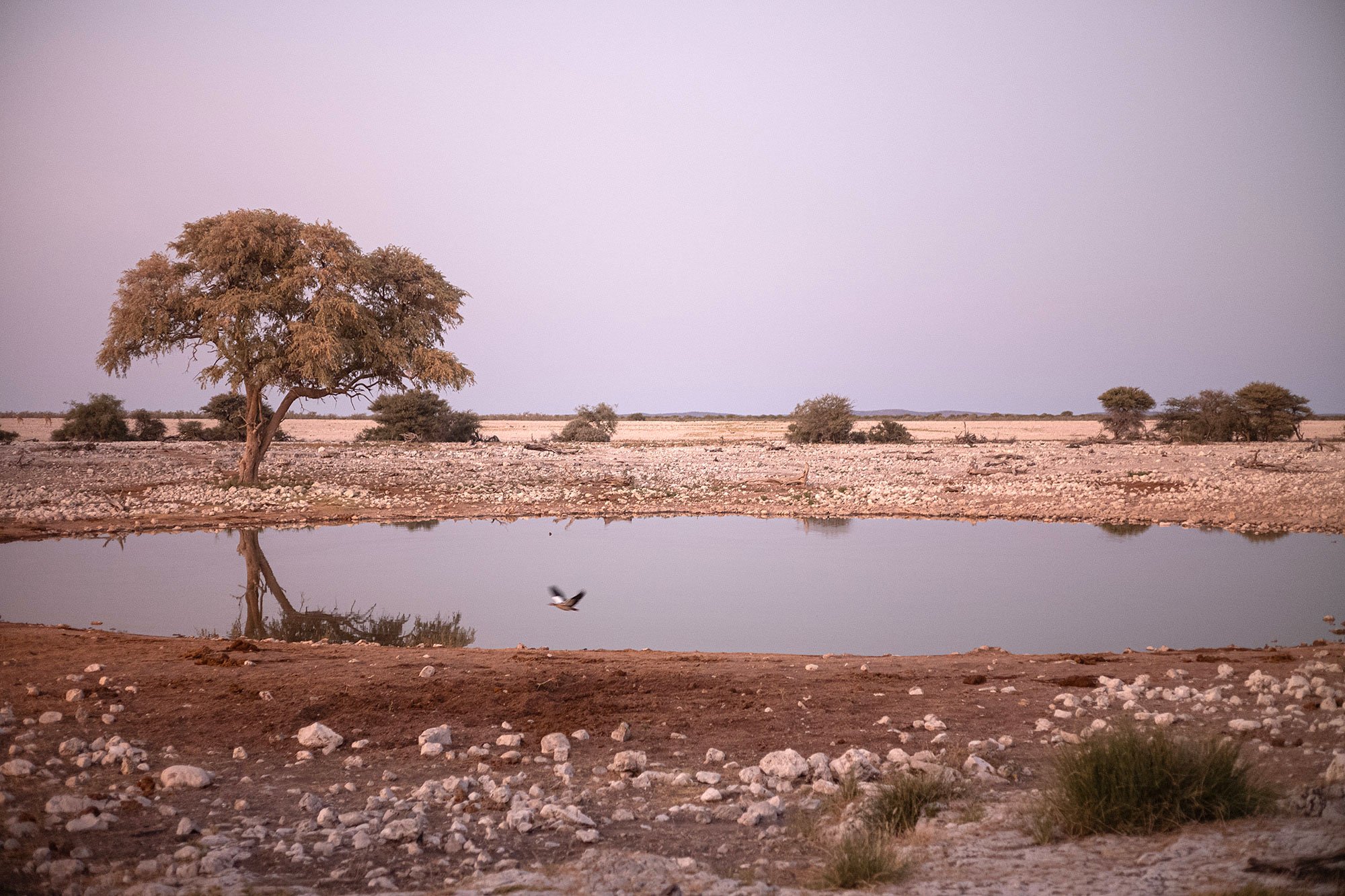
I eat a large breakfast, knowing I’ll skip lunch as I drive through the park. I head back to the chateau and pack the car. On my last trip I walk once more to the waterhole. There are few people gathered around it and even fewer animals.
I pull myself away from the waterhole reluctantly and drive to reception. I check out and then climb the tower to look out over the compound and the road ahead before climbing back into the Hilux. On my way out through the gates I note when the sun sets; it’s the time the park closes and the Okaukuejo opening and closing times.
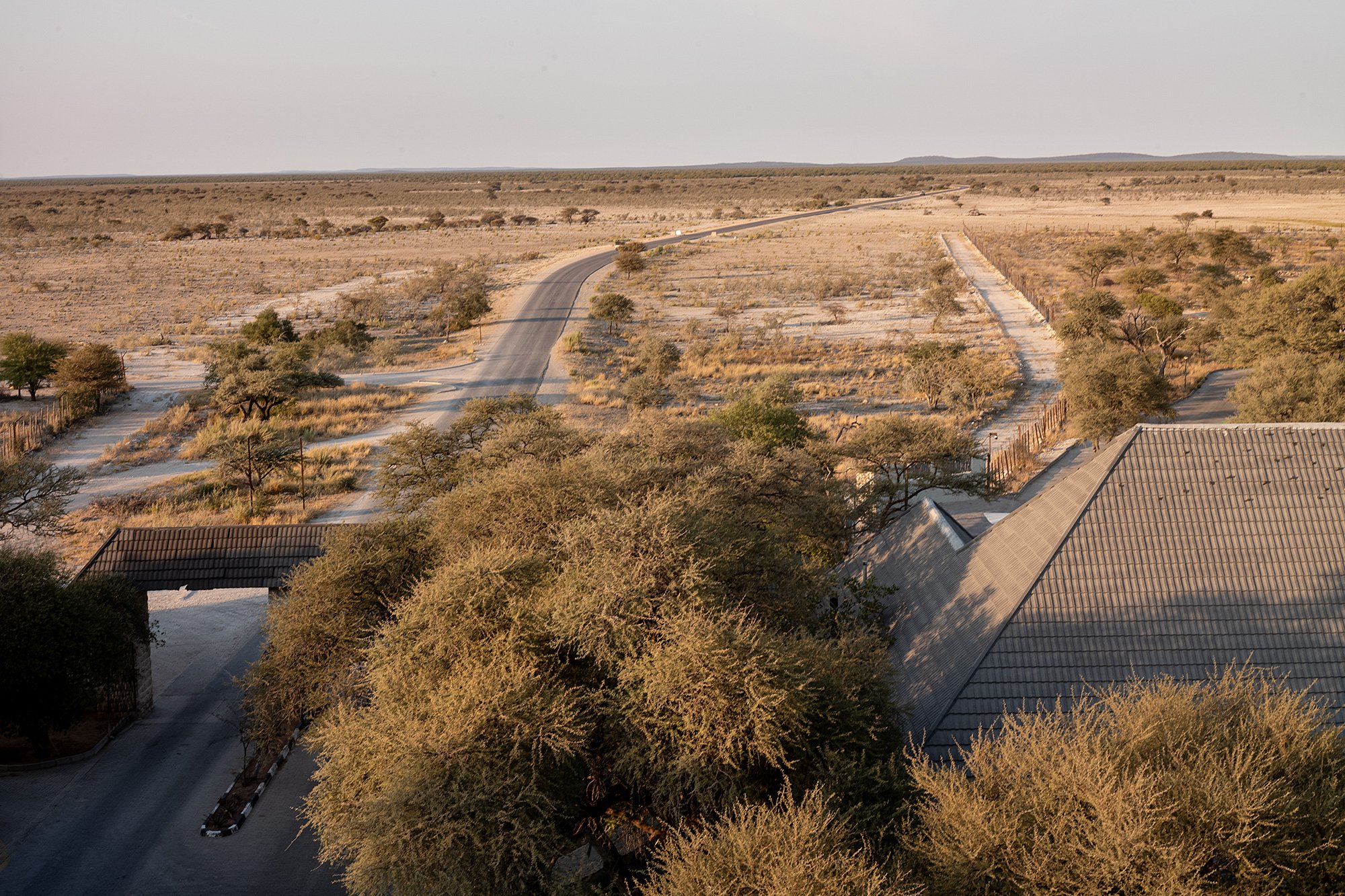
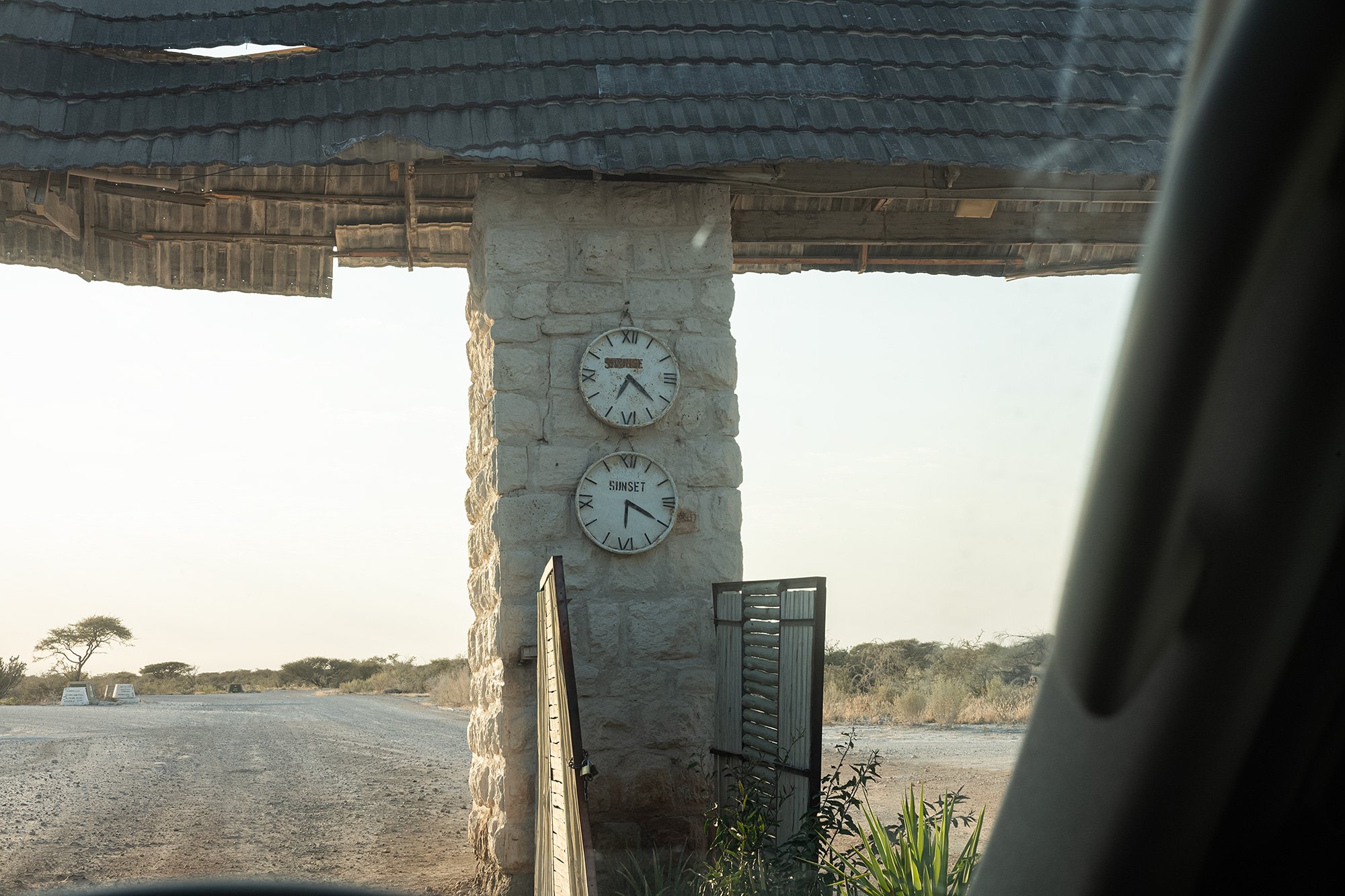
I drive east through the park. The sun rises over the pan, and I open the windows so that I can breathe the fresh morning air. The landscape stretches unbroken towards the horizon.


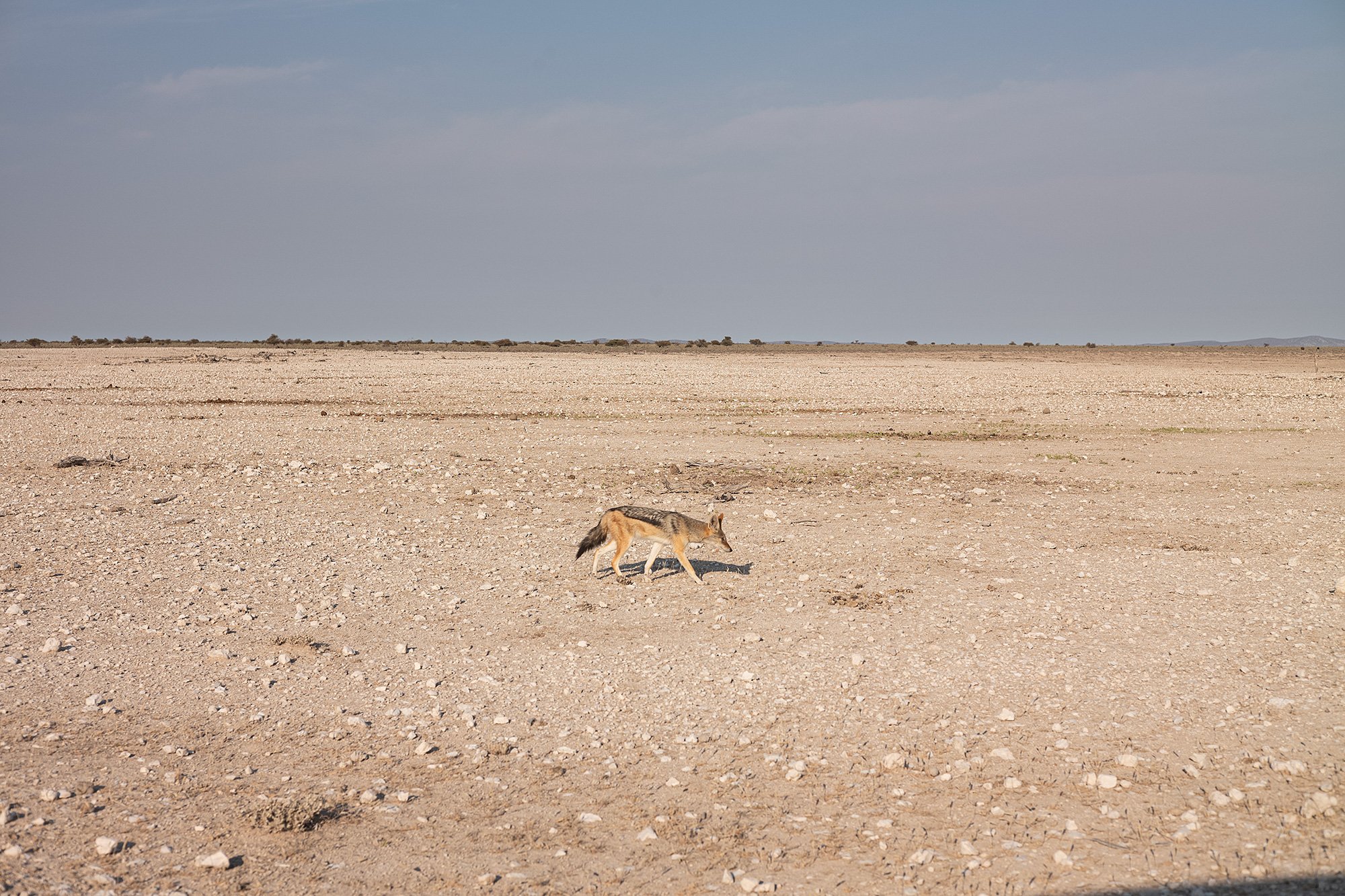
It’s early in the day and I decide to follow a detour from the main road to check out the Gemsbokvlakte, Olifantsbad and Aus waterholes. The road passes all three before looping back to the main road that passes northeast through the park.
As I take the right and follow the road I see a lone giraffe far off in the distance, almost lost in the shrub. The road continues on a vector that will intercept it if it continues on its current path, but I can’t help but pause now and again to take photos of our progress. It’s beautiful spotting the giraffe on the plain, and fun following its progress.
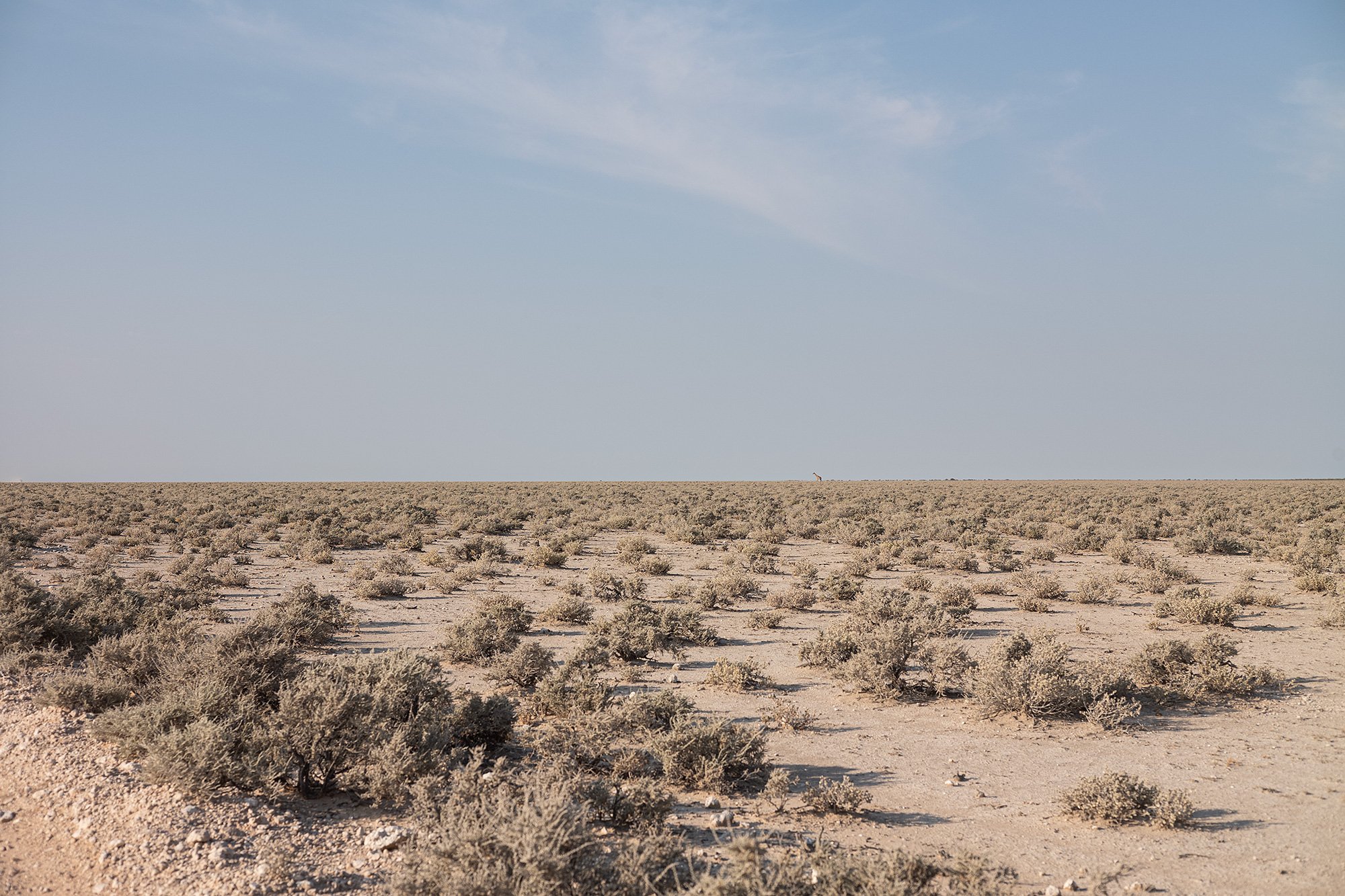
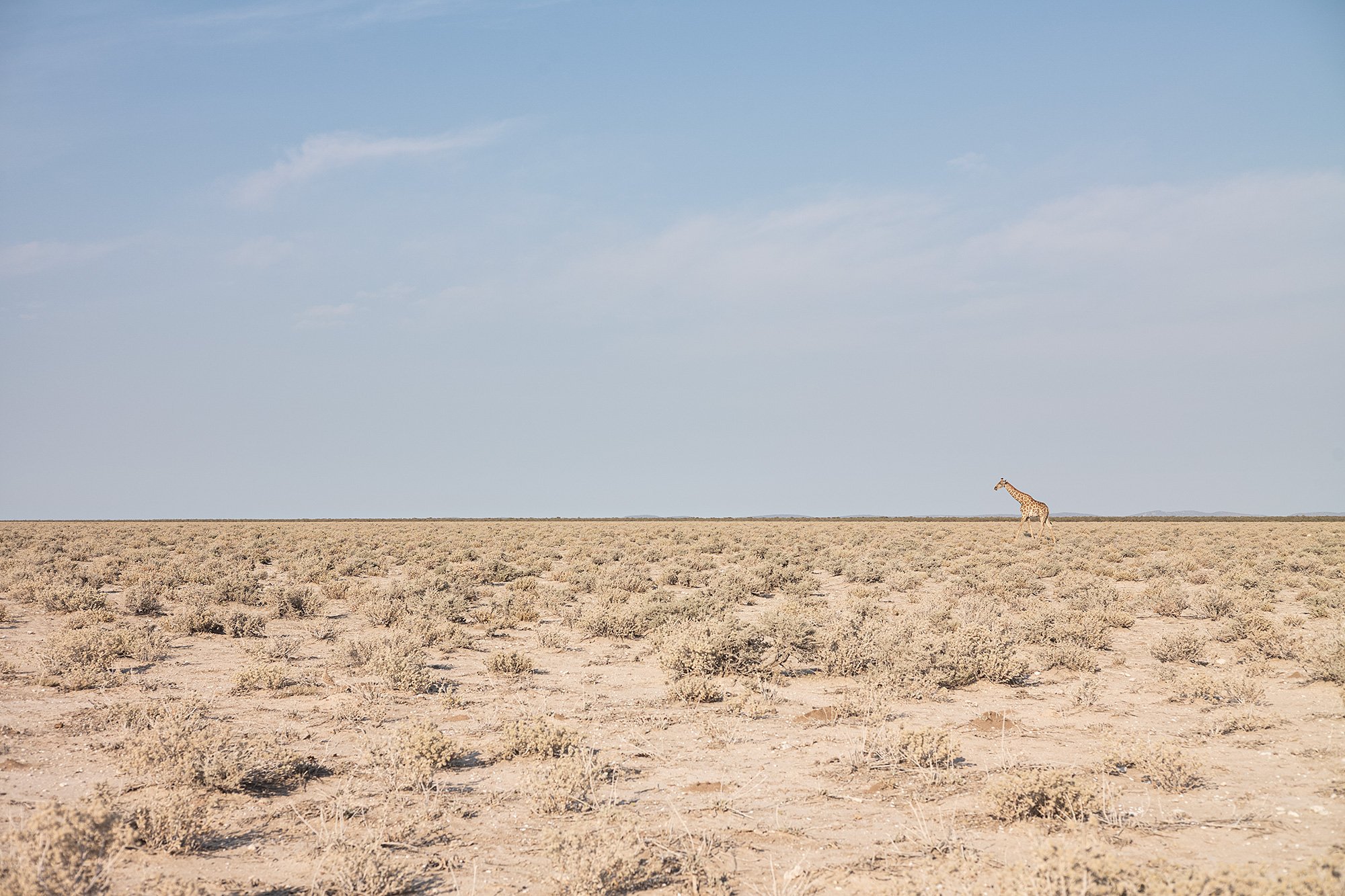
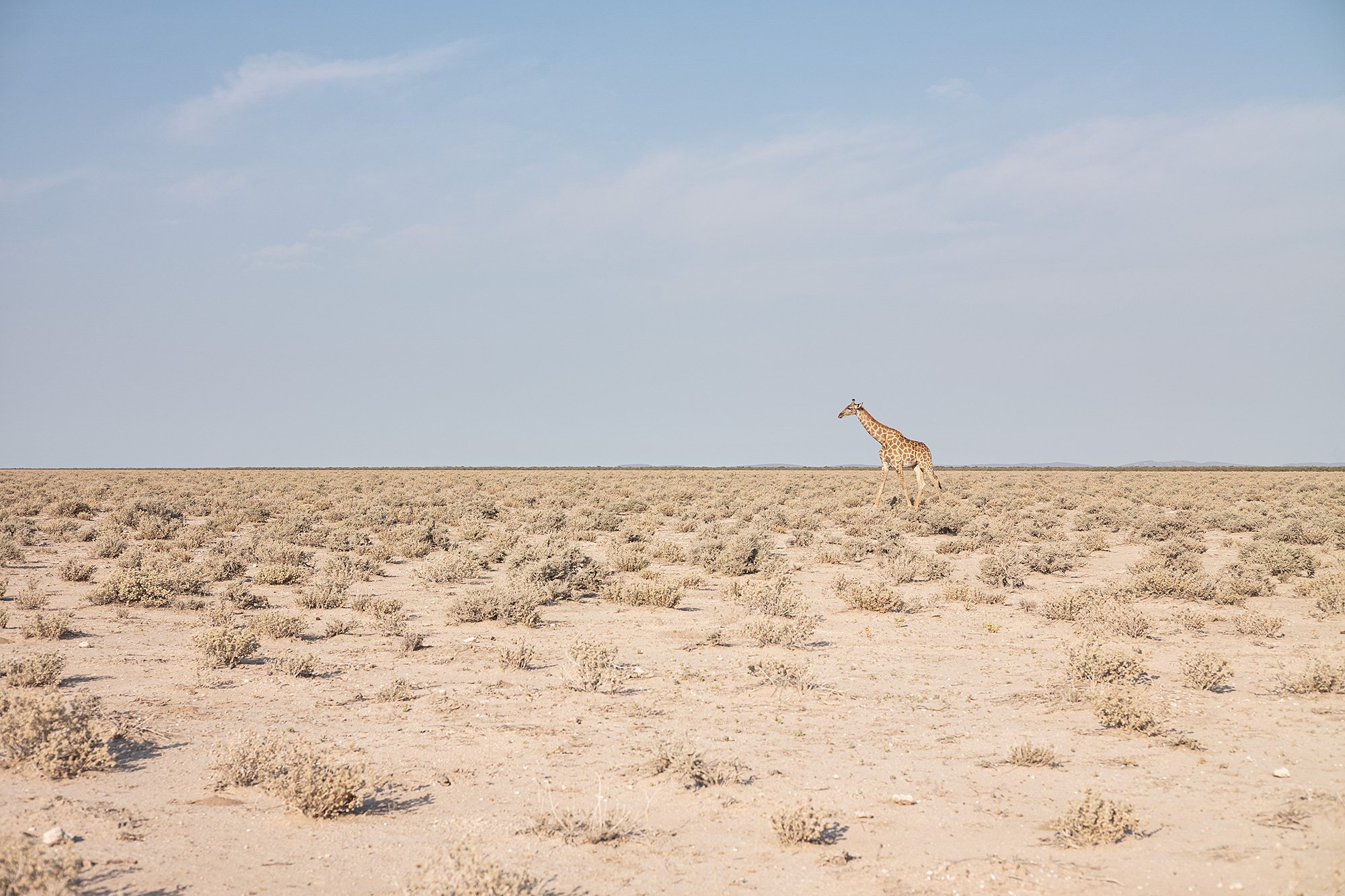
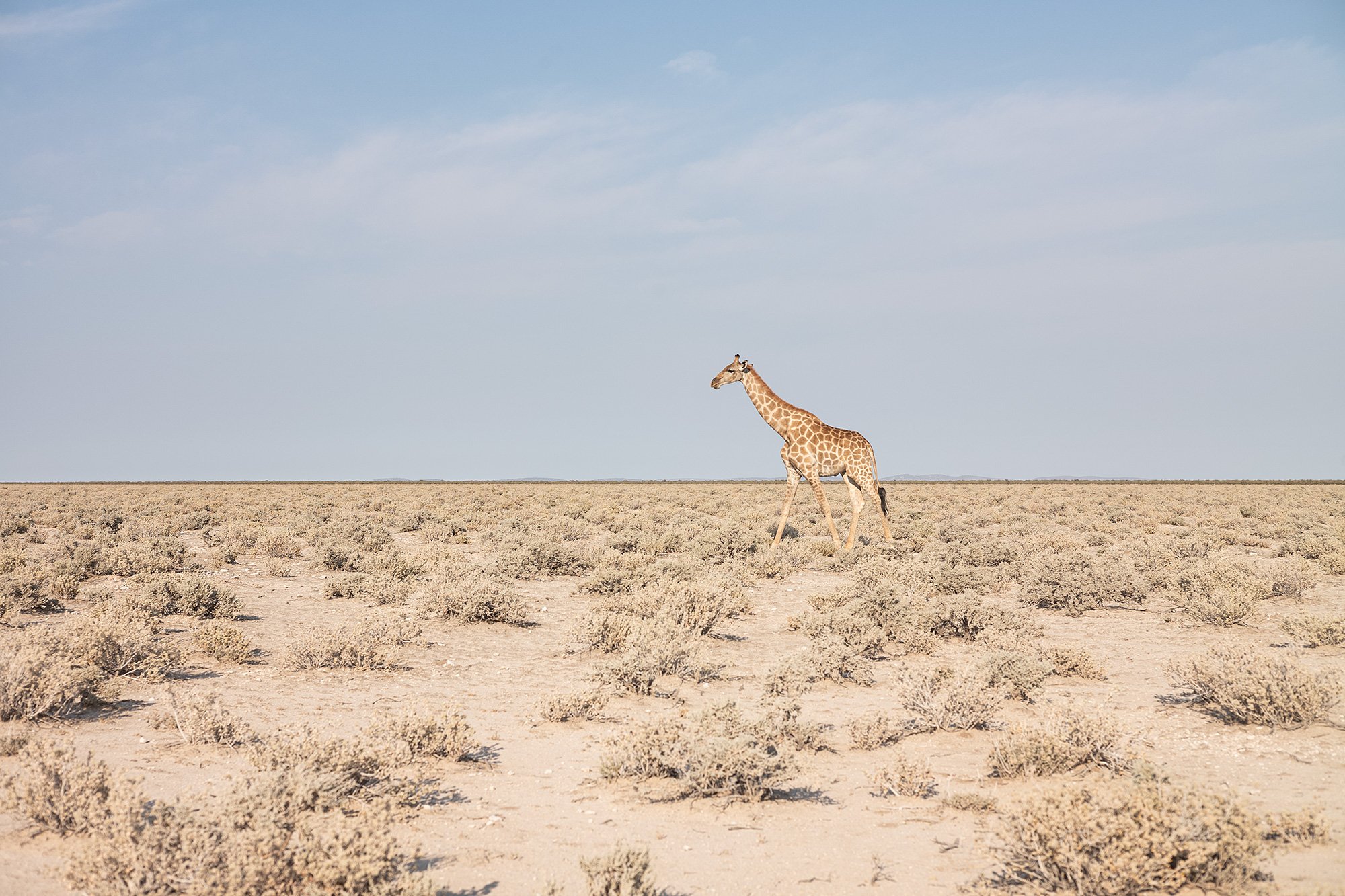
I follow the road to the waterholes, spotting impala, ostrich, wildebeest. There’s a small gated parking lot at Olifantsbad and I take advantage of it to use the restroom. As I turn towards Aus, I see that the road ahead is closed. I’ve done 2/3 of the loop and am forced to backtrack in order to continue my journey east. I wonder why no signs were posted when turning off the main road warning of this plight.
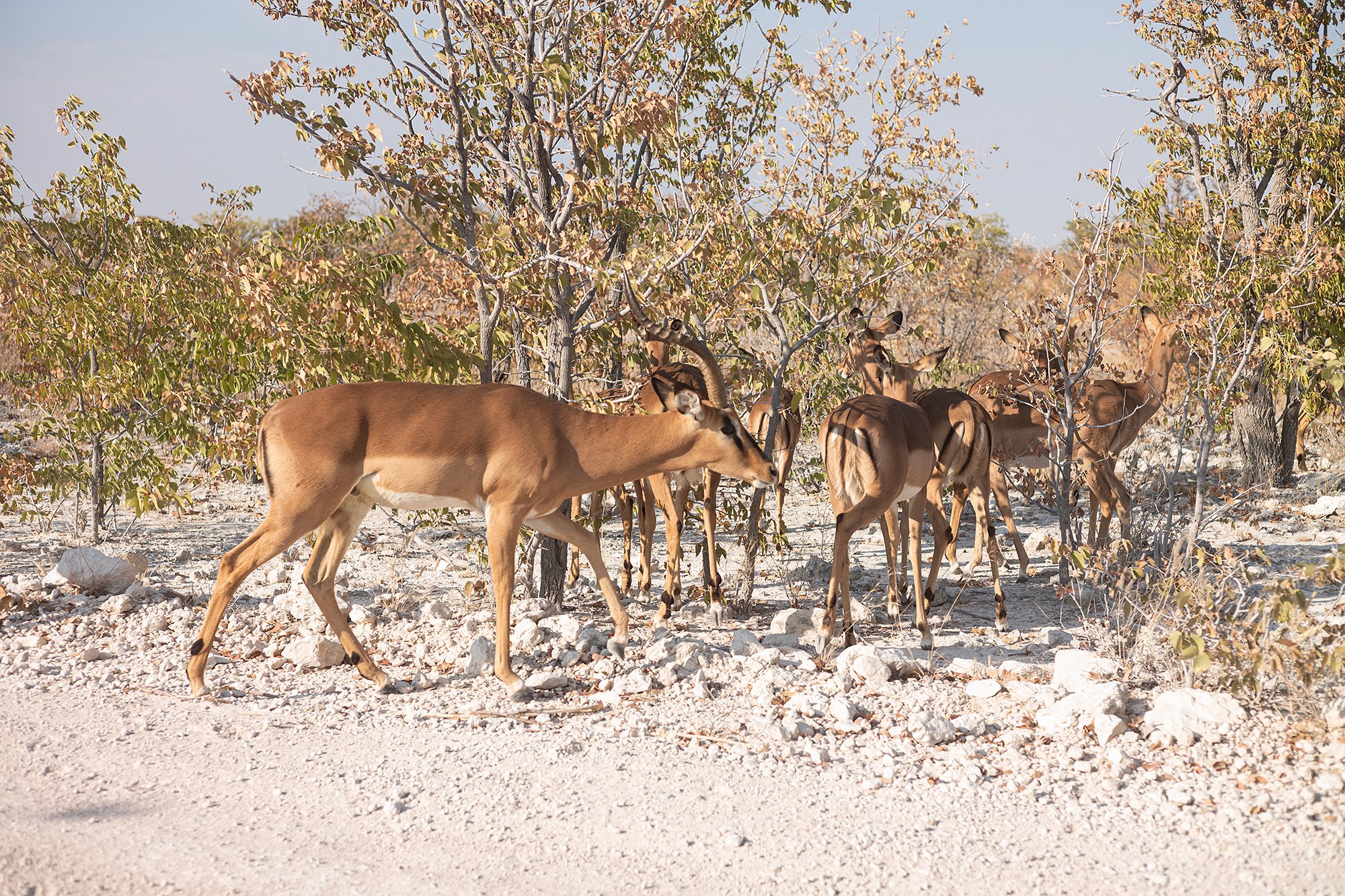
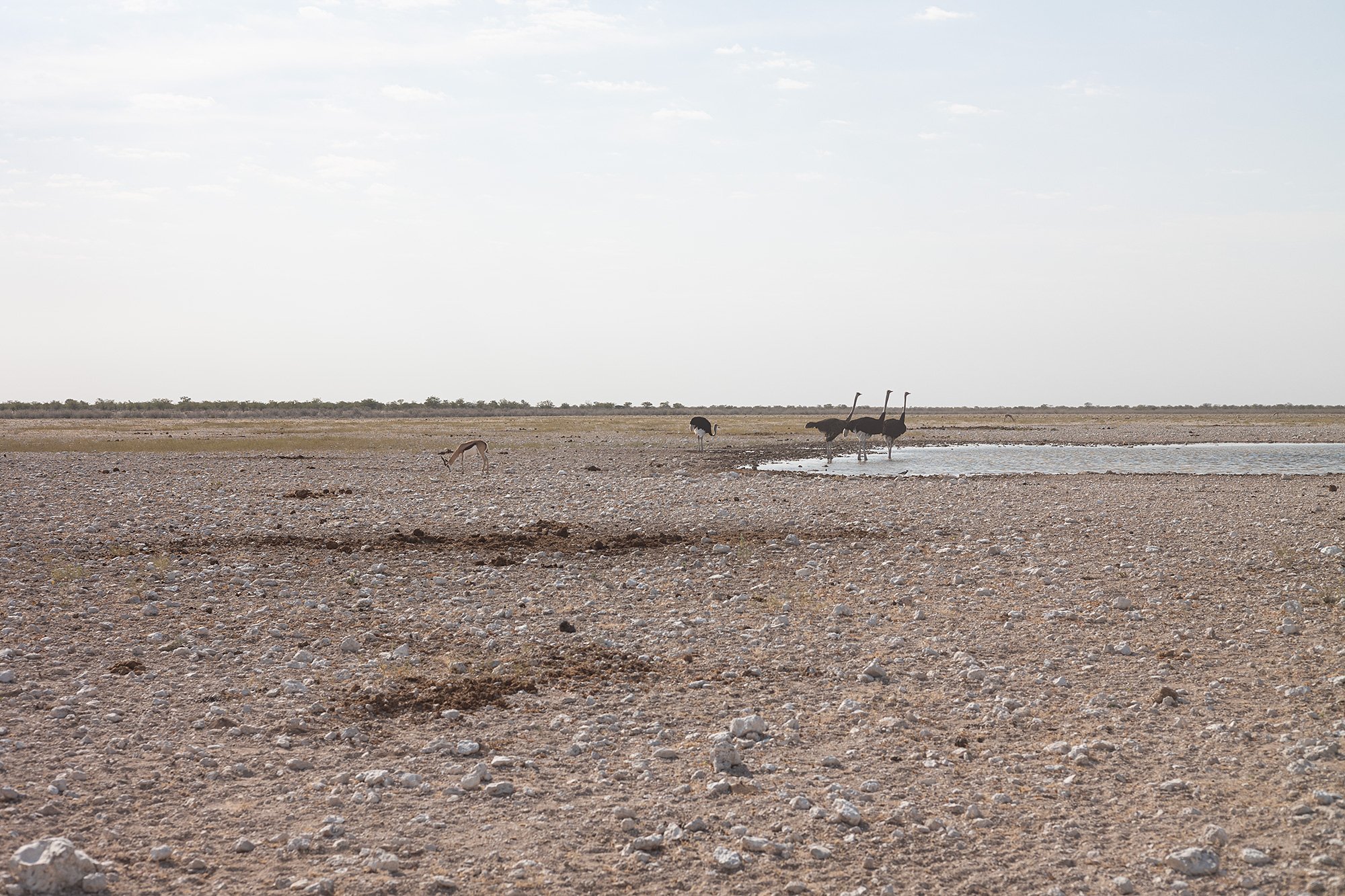
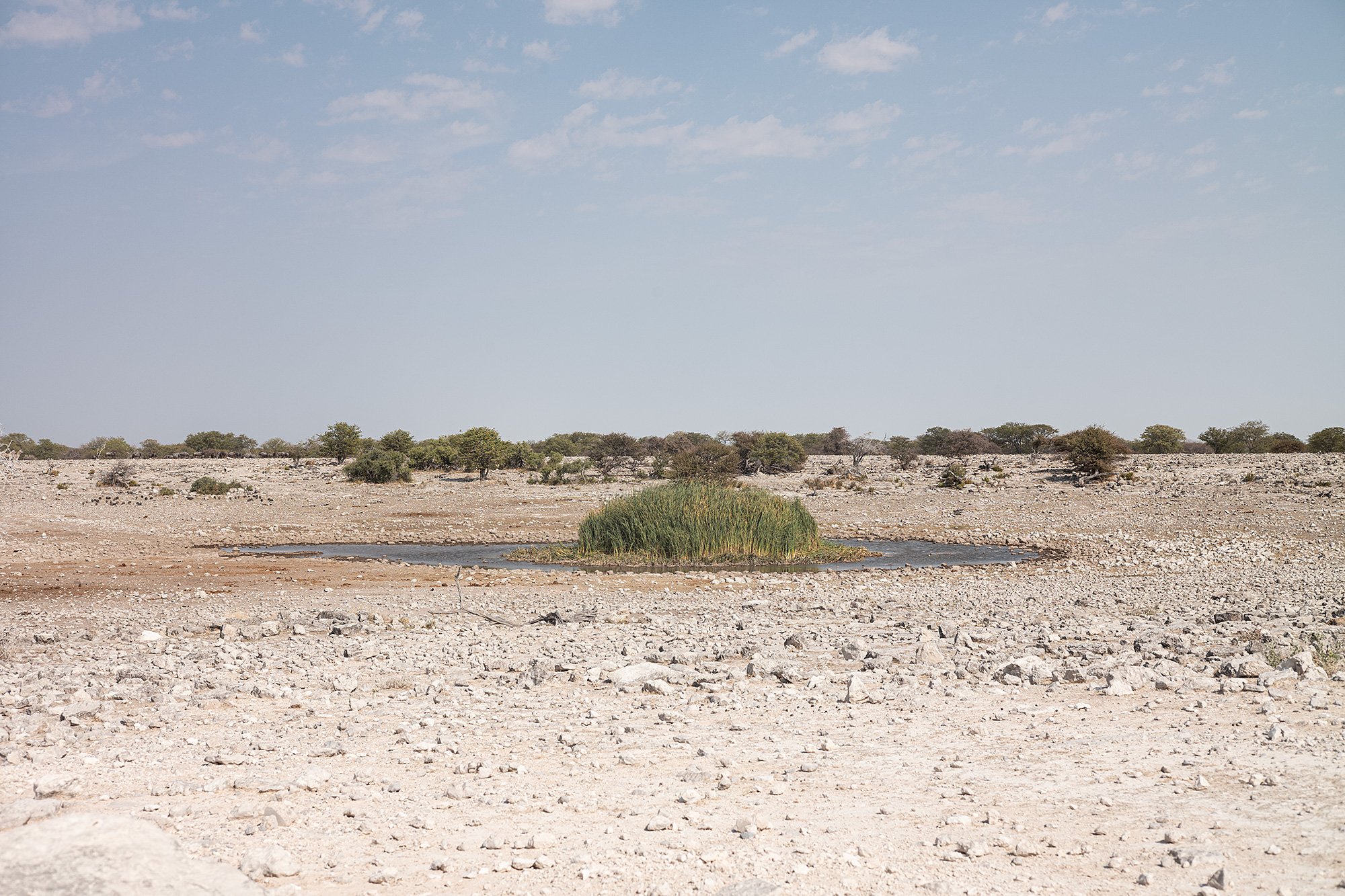
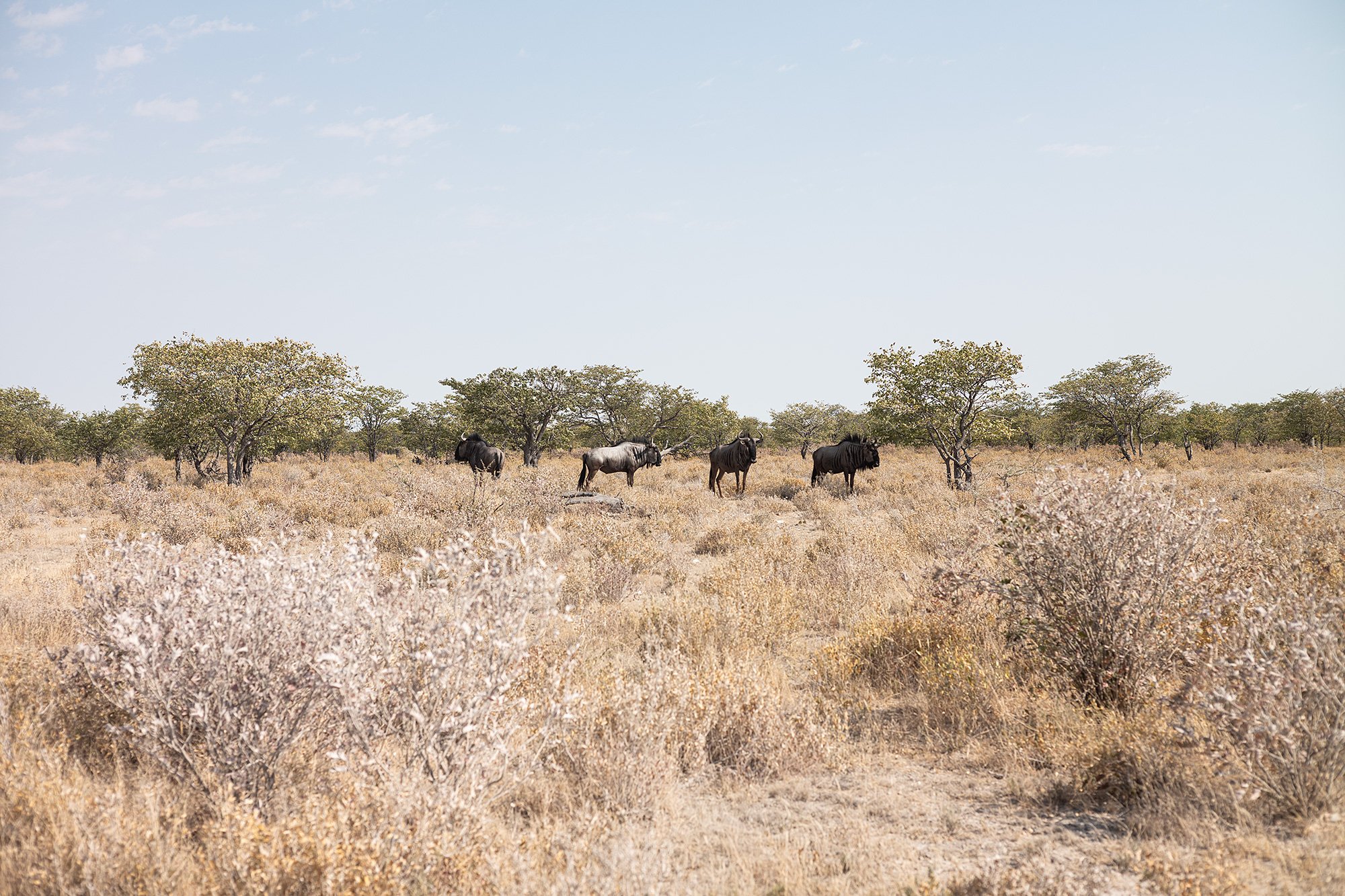
Further along the main road I choose to take another detour in order to hug the Etosha Pan, the large salt pan that gives the park its name. In fact, the word “Etosha” means ‘great white place' in Oshindonga. It’s a beautiful drive, the landscape unlike any other in Namibia.


A small herd of zebra appear and I stop to take photos of them as they make their way alongside the pan. I start the car and begin to reverse in order to get a better angle on a zebra and am startled by a honk behind me. I’m so enthralled by their presence and the landscape that I hadn’t noticed a line of cars and safari vehicles have stopped behind me. I wave by way of apology and then put the car in gear to continue onward in hopes of getting in front of everyone.




I drive on, awed by the landscape and the animals I pass. More zebra, springbok, ostrich, wildebeest. I’d be hard-pressed to answer which I find more captivating; in the end it’s the combination that makes everything so perfect.


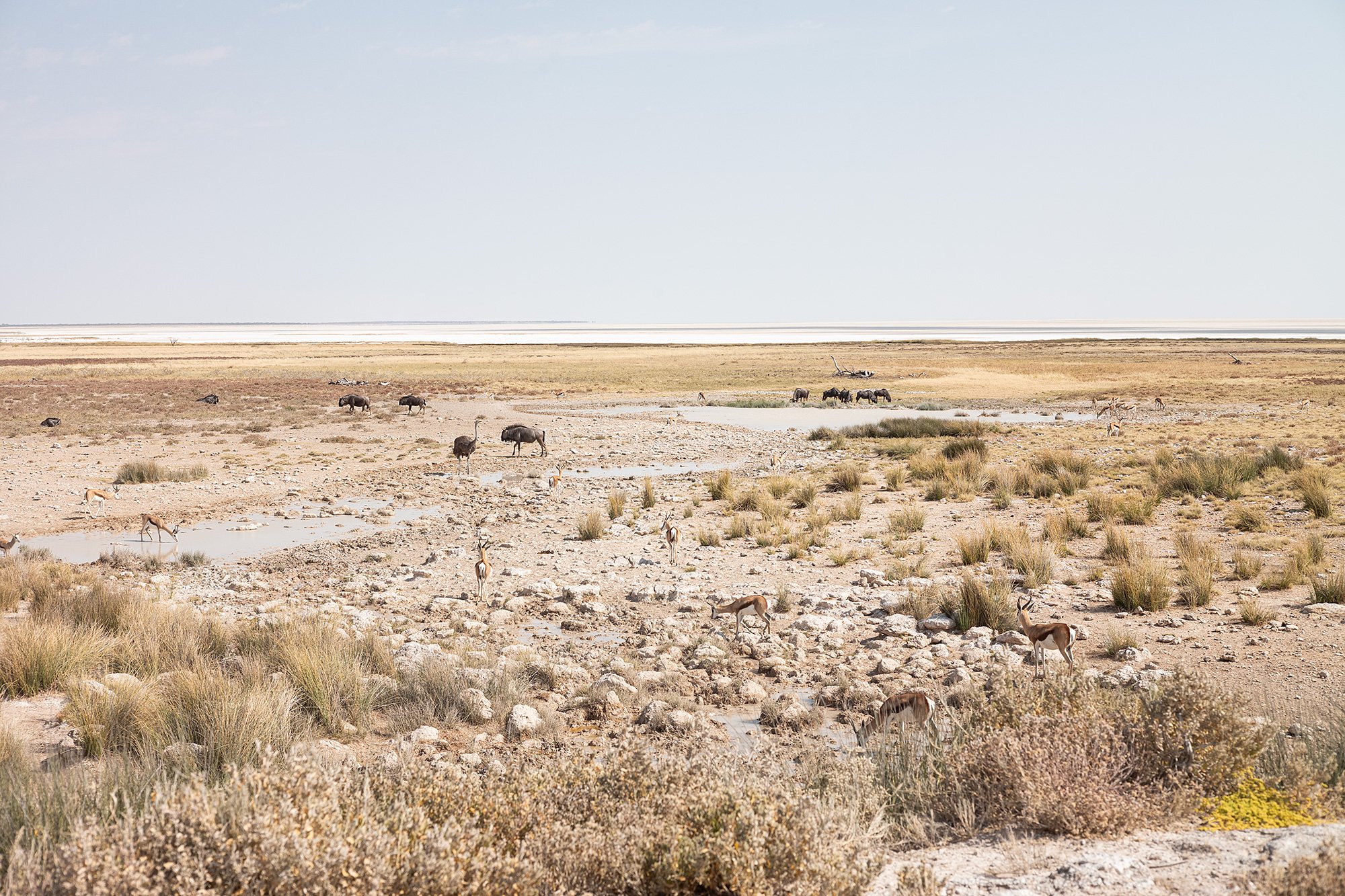
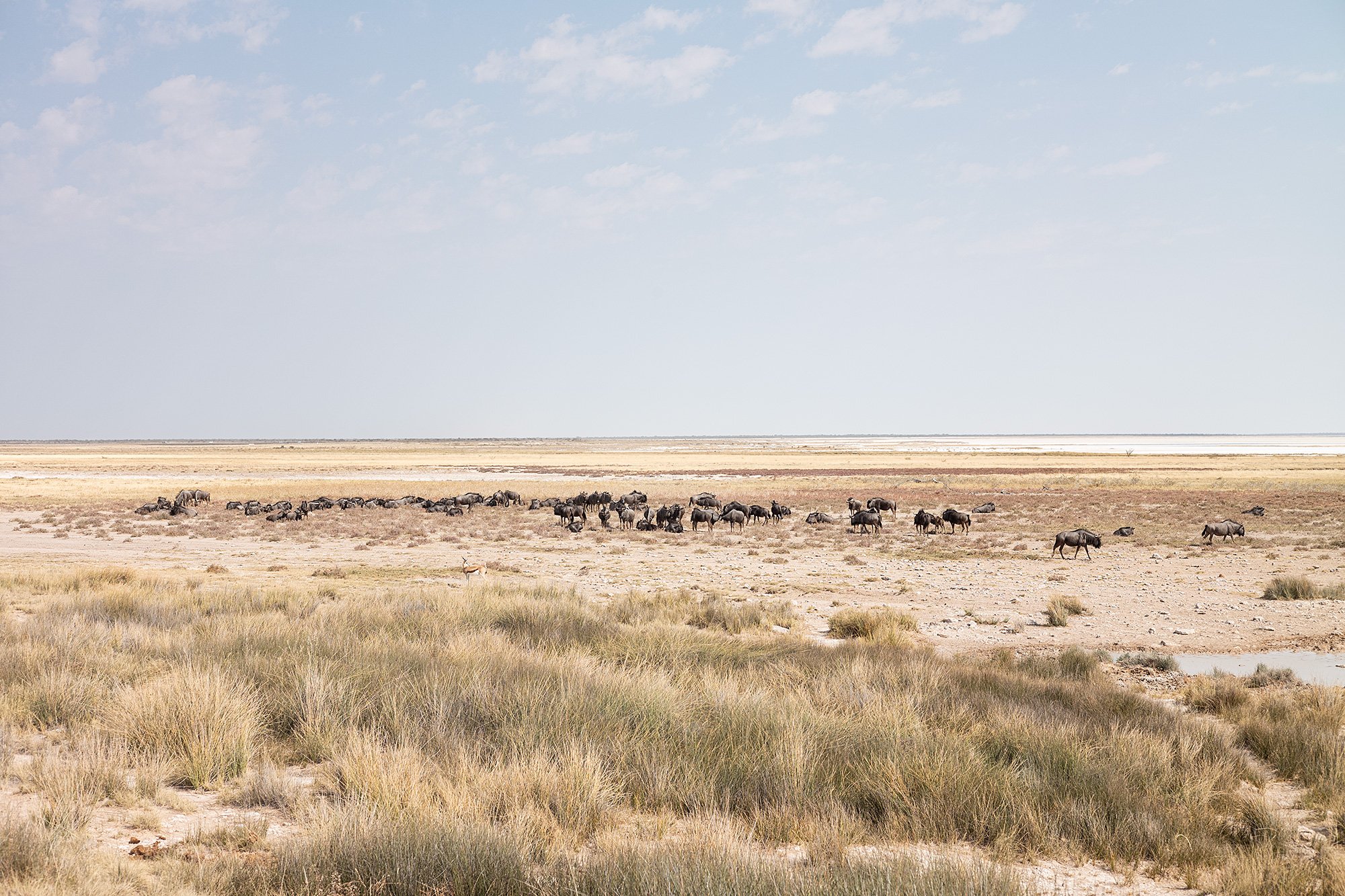
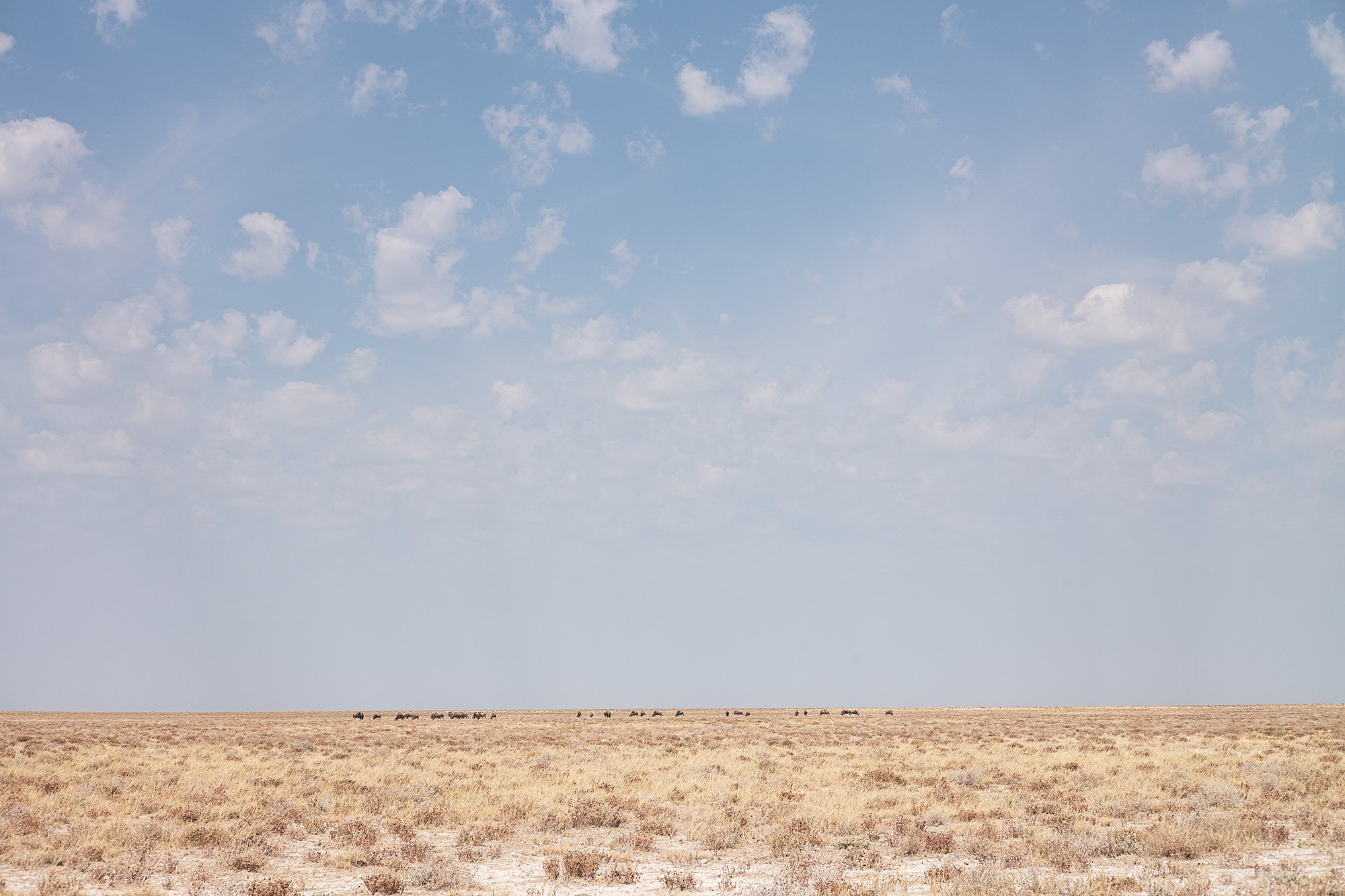

I take the turn for the Etosha Pan lookout and find myself driving on the salt pan, the “road” marked with wooden stakes. Impala lie impassively on the pan, their bodies the only thing rising from the otherwise flat terrain.
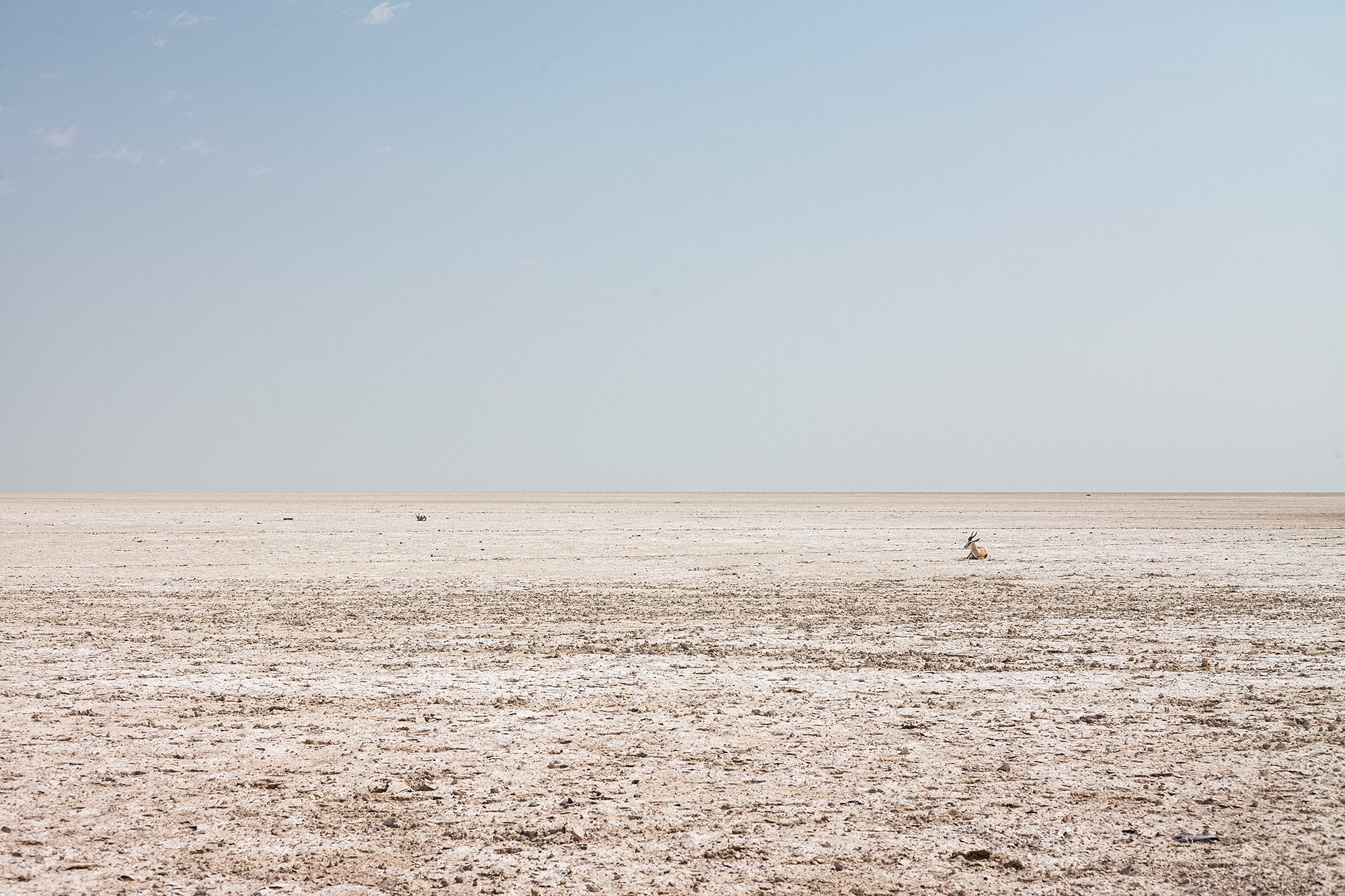
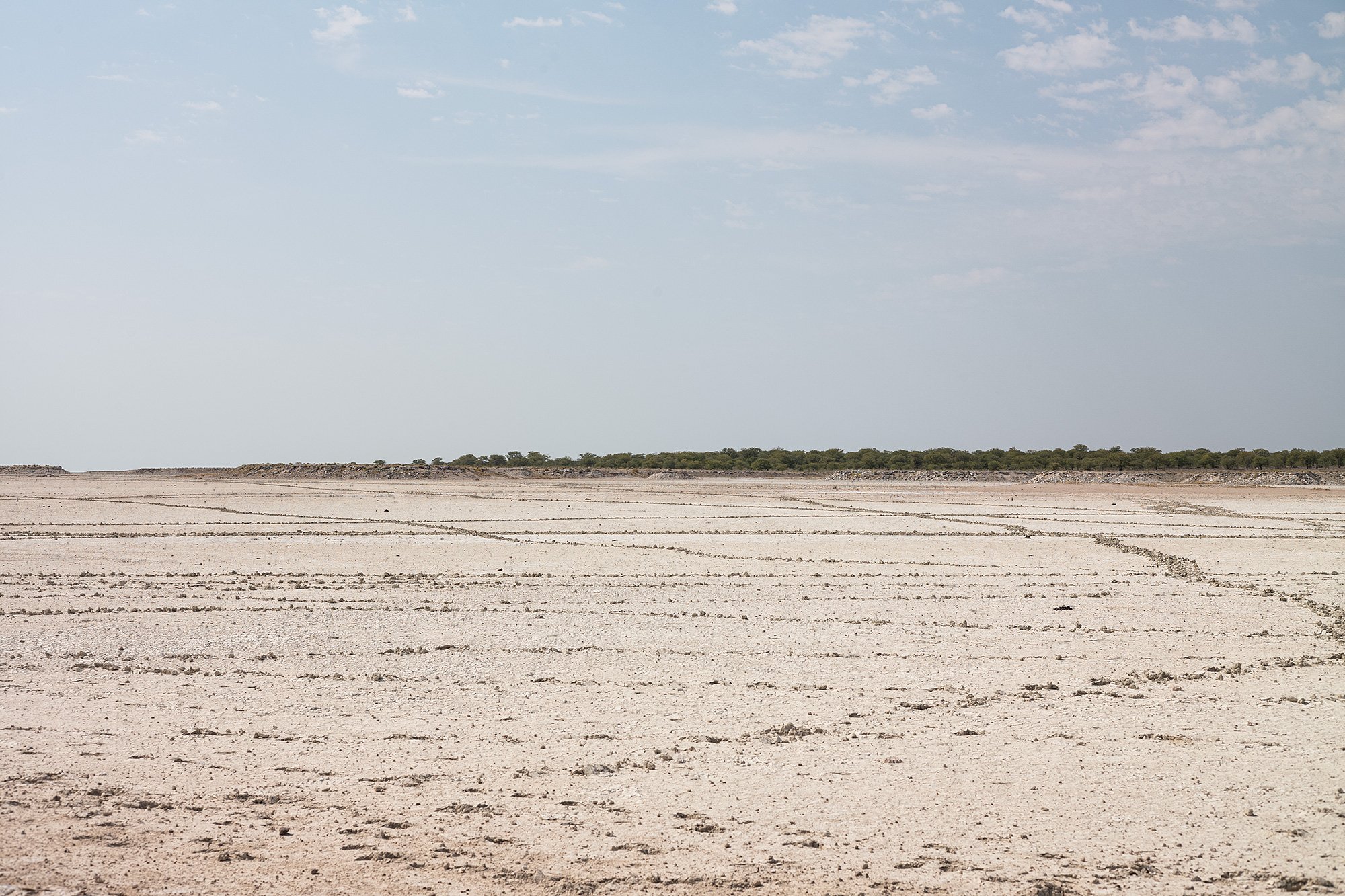

Reaching the end of the road, I take photos of the pan as it stretches out towards the horizon. Although it’s seemingly comprised of the same material, there’s interesting color variations between the different areas of the pan: reds, yellows, greens. It’s an awesome sight.
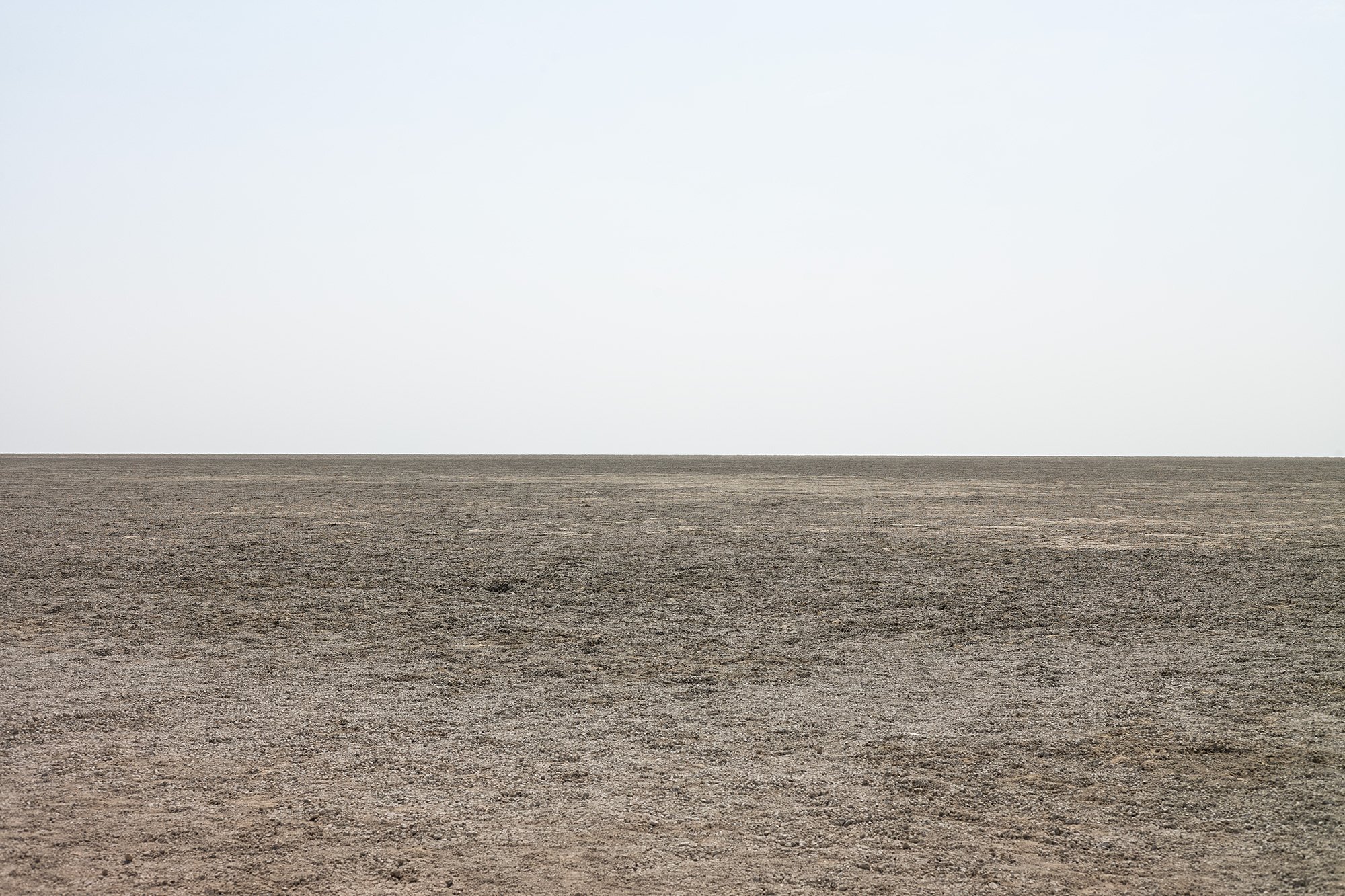

I turn around to head back to the main road. Looking back, the pan on either side of the road displays a different color. I drive slowly back, looking at the various trails animals have left in the pan. I can’t imagine crossing it. The road I’ve just driven barely leaves the edge of the pan behind.
The impala haven’t moved from their spots. I wonder how long they’ll sit before they move on, in search of water or grass.
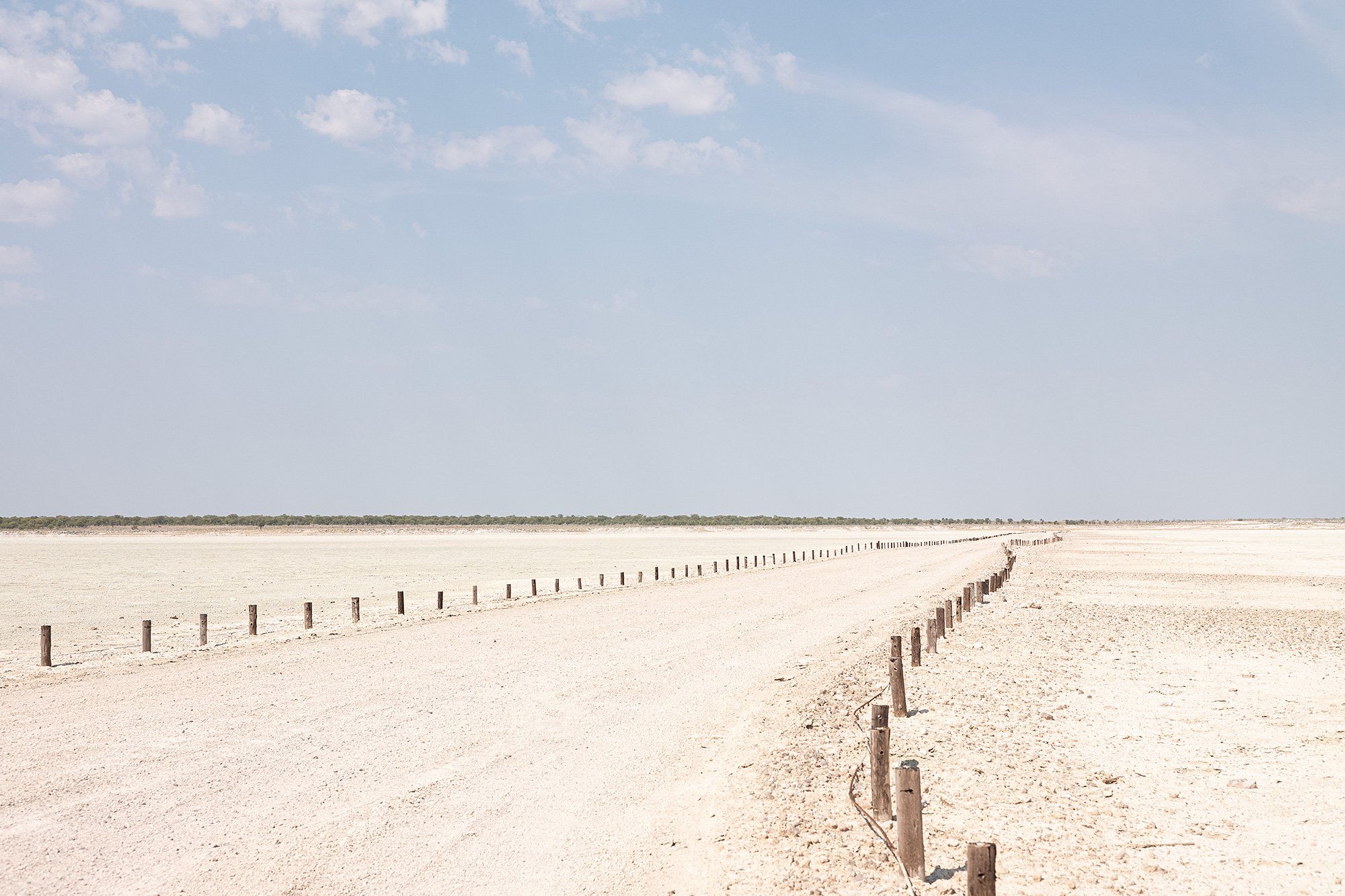

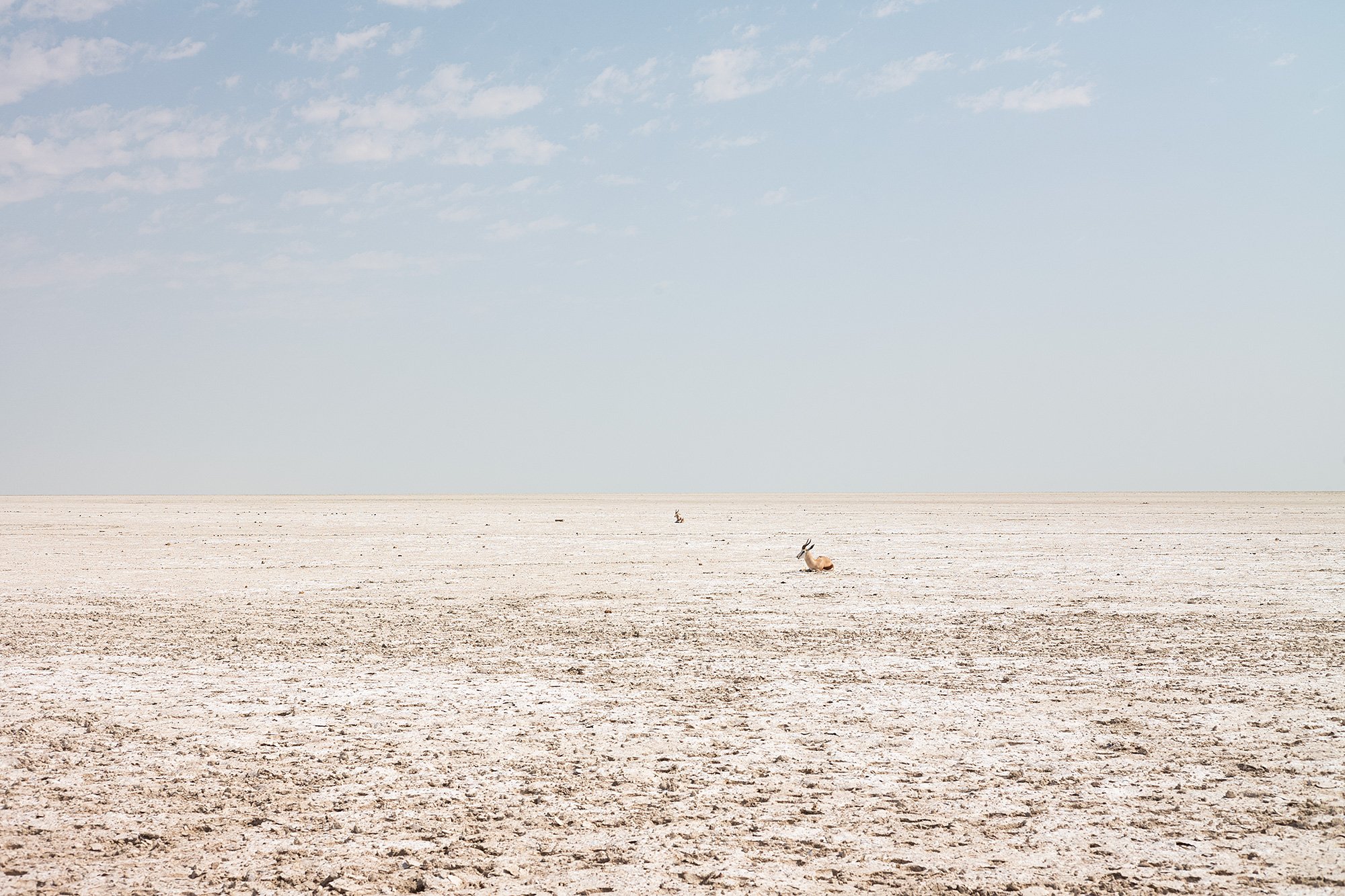
Leaving the pan I continue driving along the detour until I reach the main road. Riverbeds lead away from the pan, disappearing quickly into the dry land. Sunlight streaks through the clouds, across the horizon.
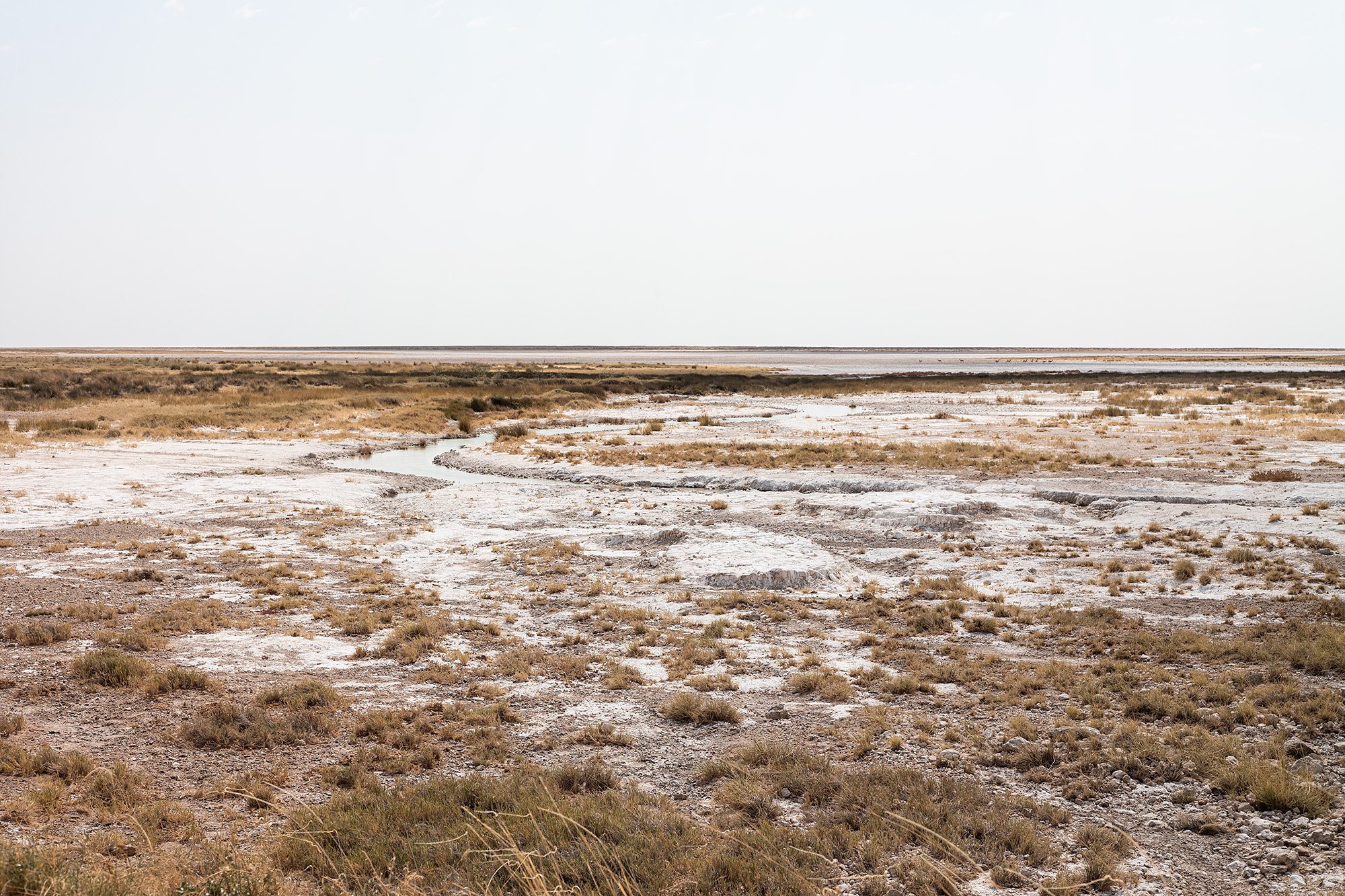
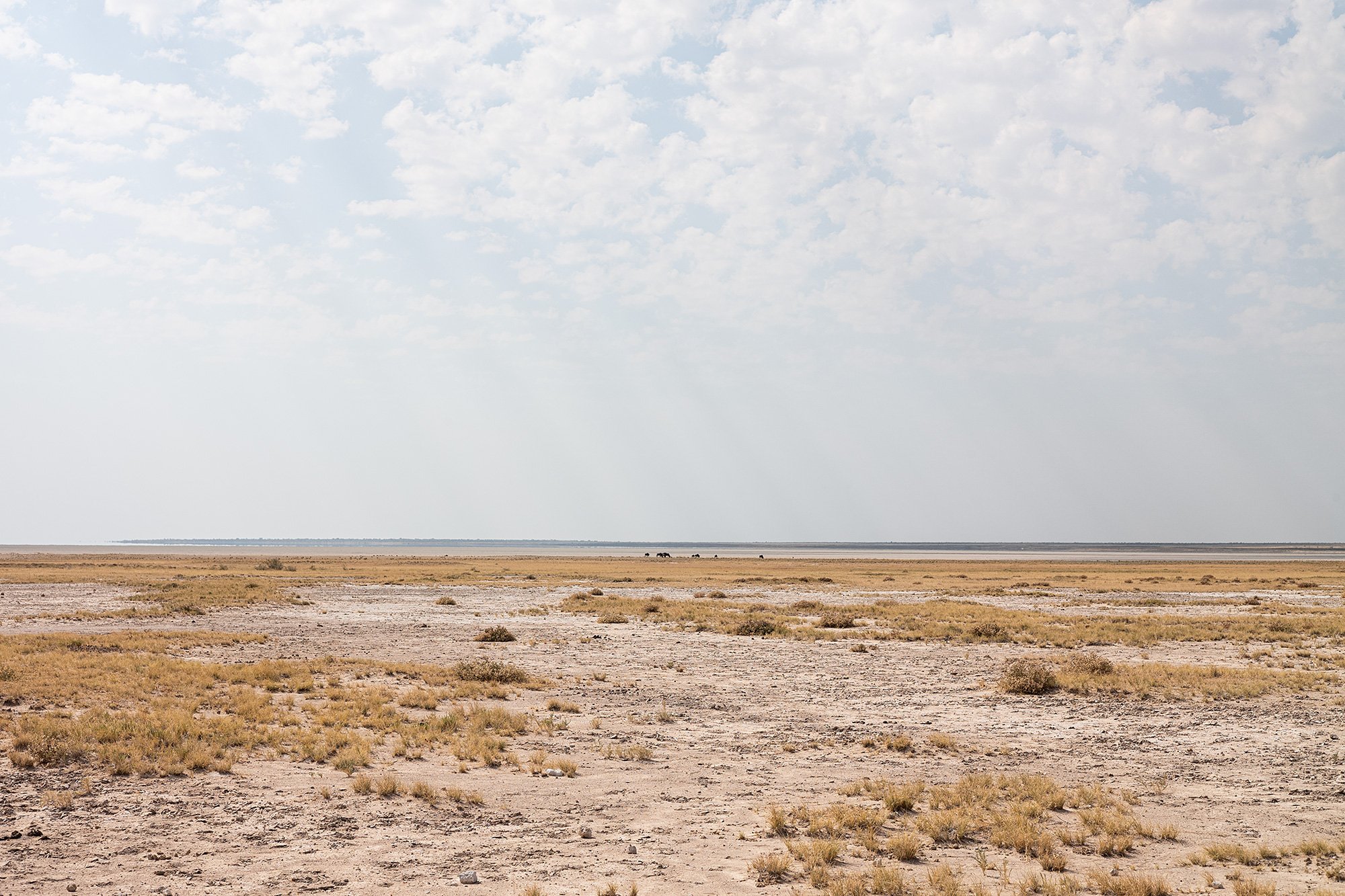
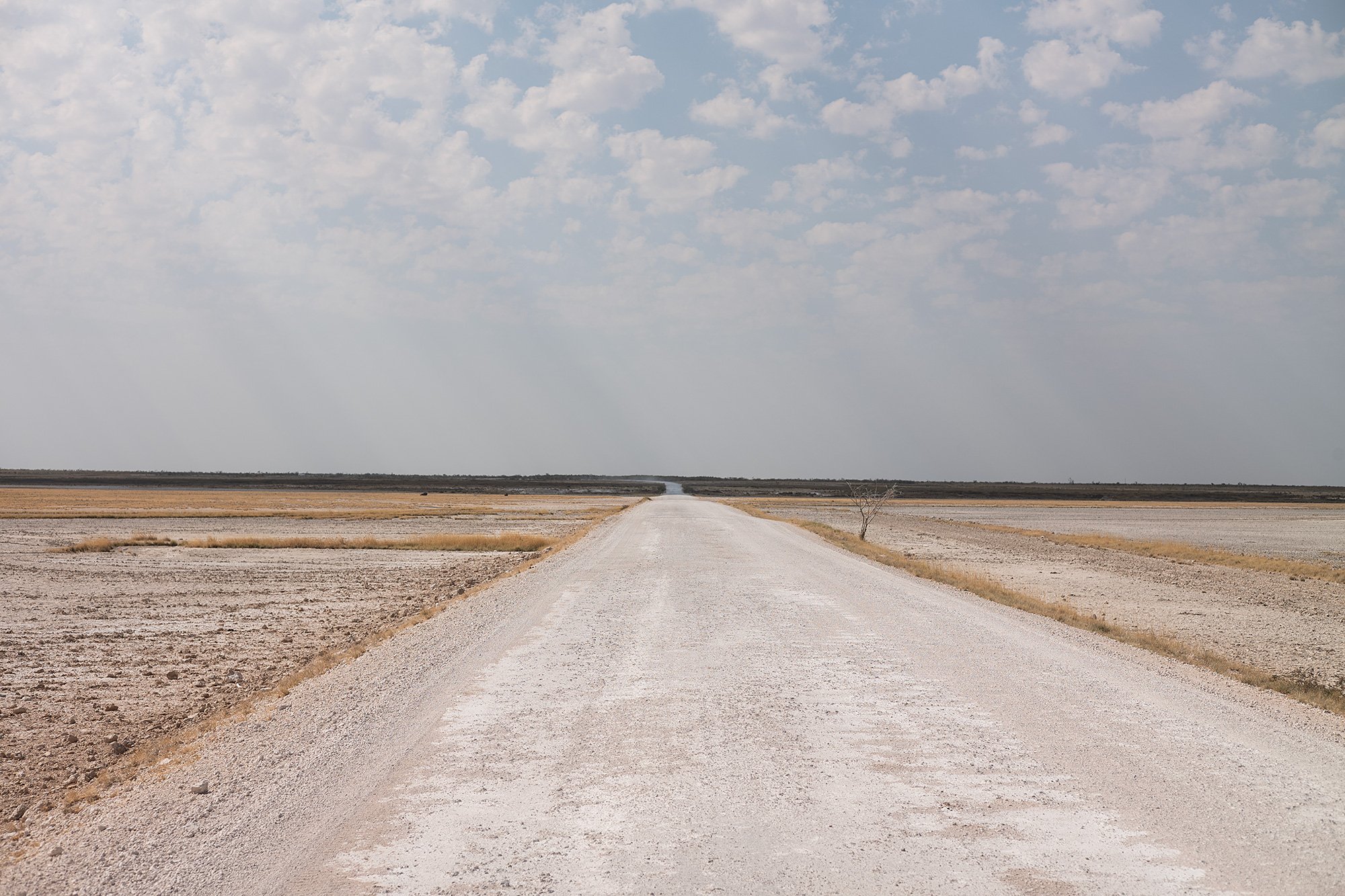
The road winds away from the pan and I’m sad not to be able to continue following it. Now and again I can see it in the distance, on the edge of the grasslands. I pass impala and wildebeest and ostrich as kilometer after kilometer tick by.

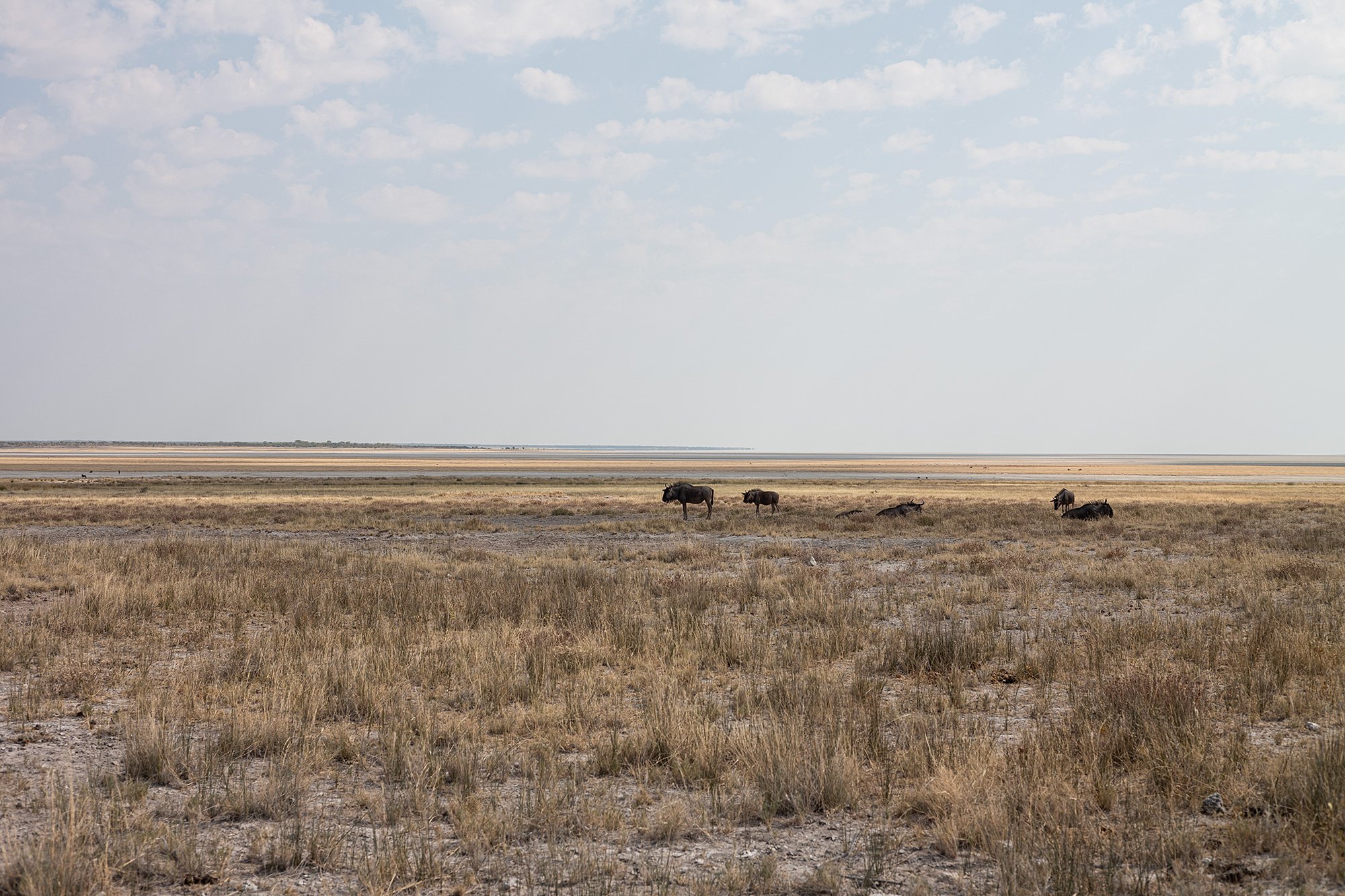
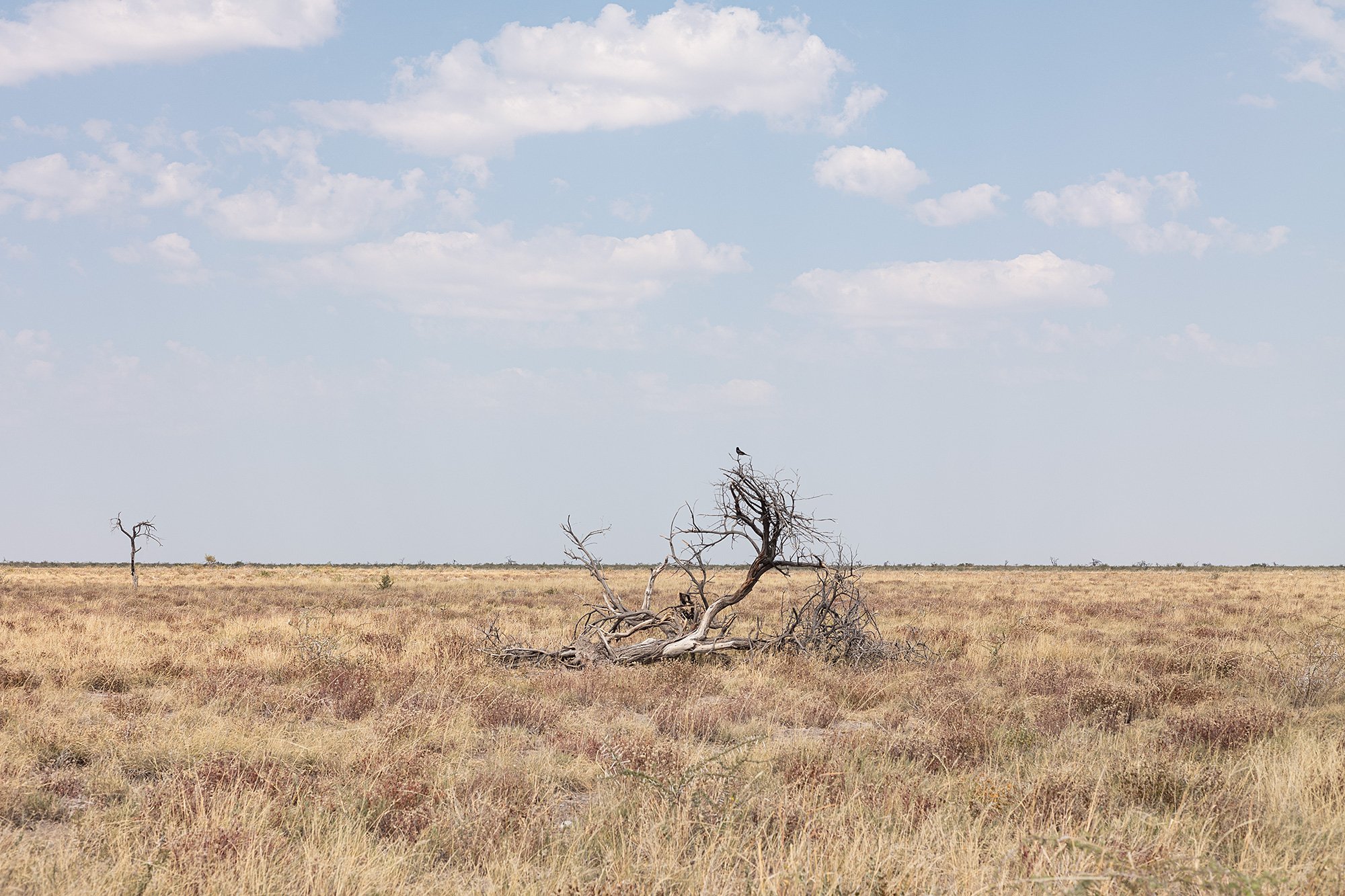
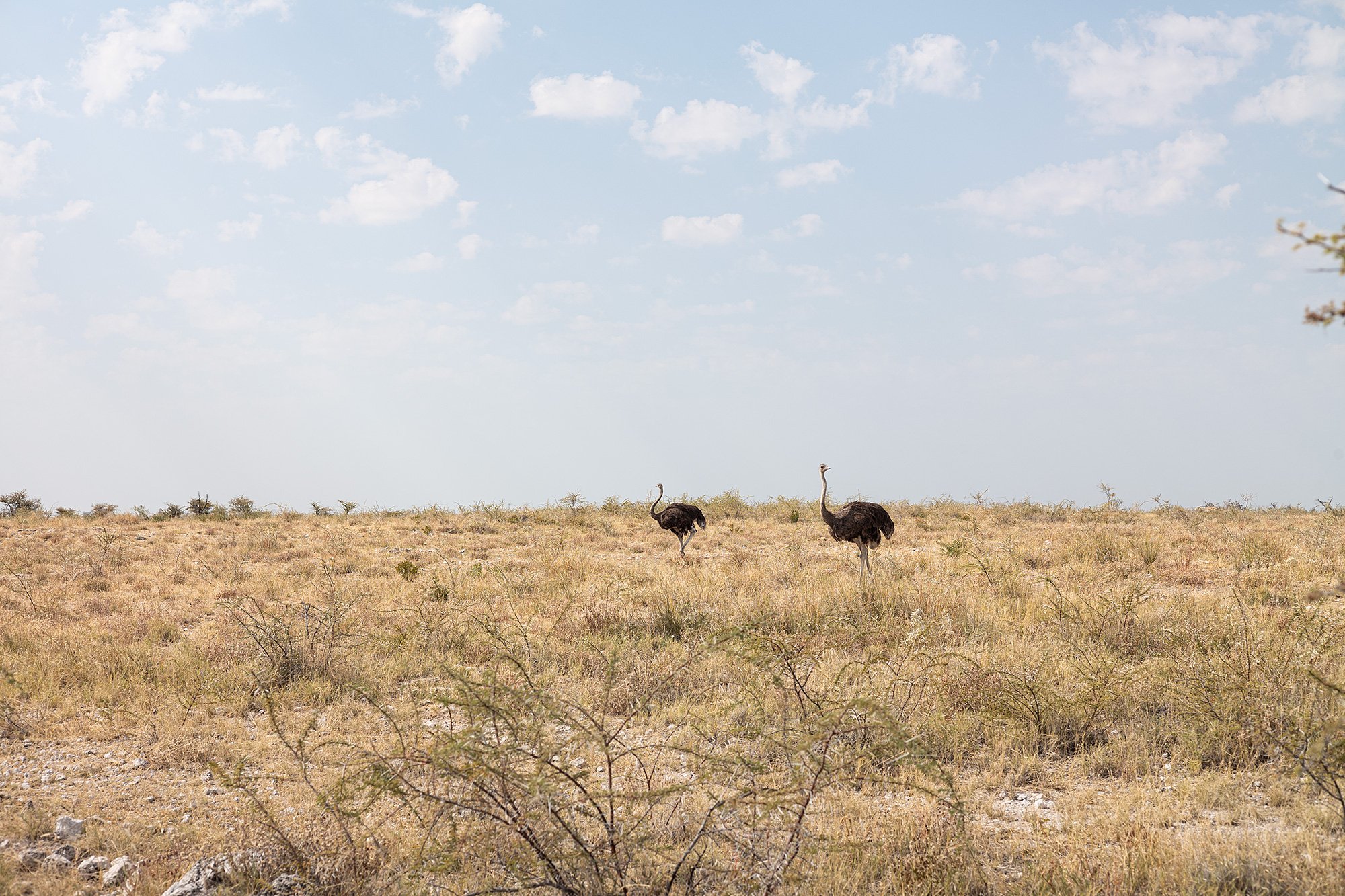
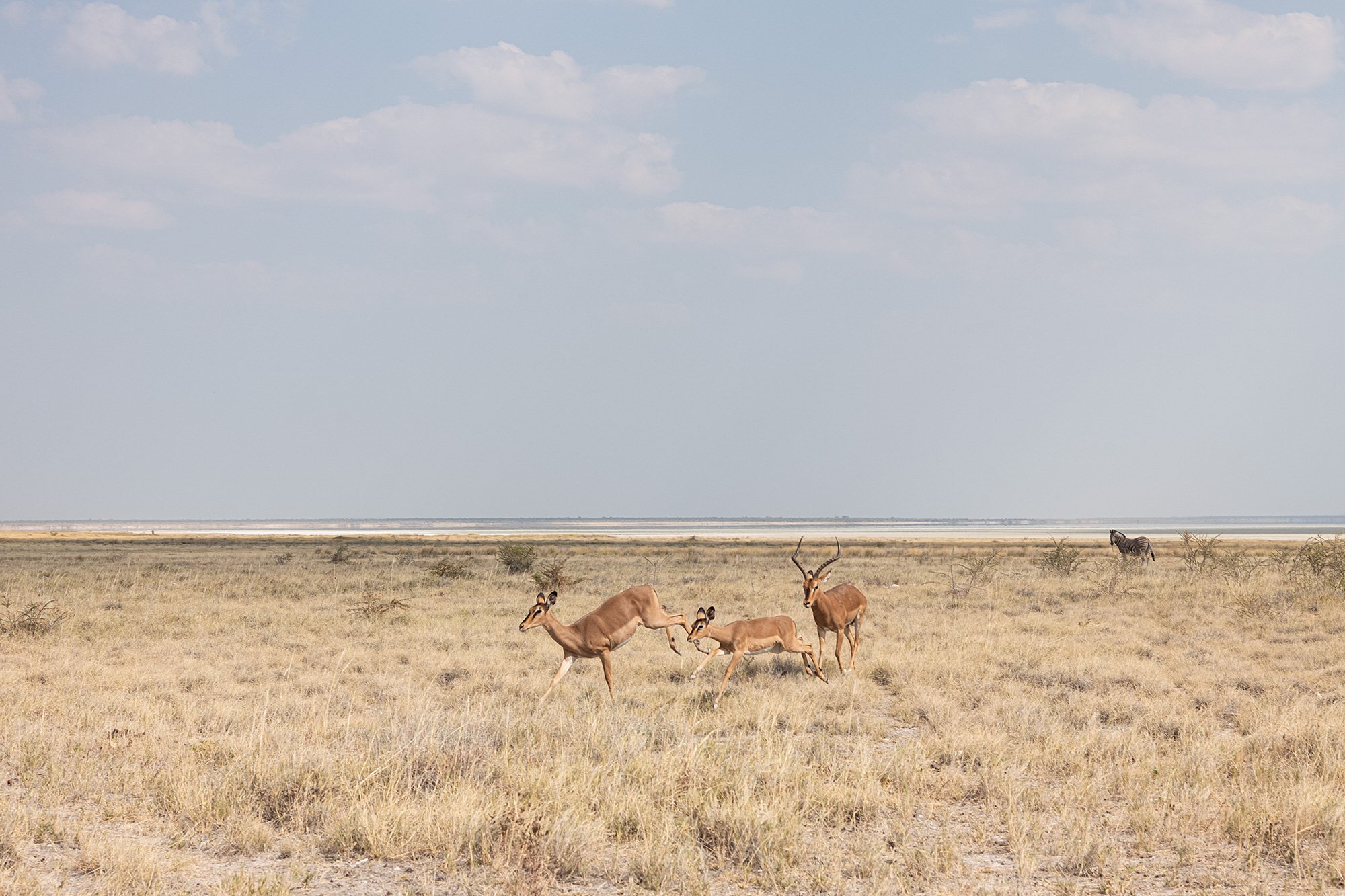
Near the Batia waterhole a detour veers off to the left. It hugs the pan and I take it, eager once again to admire the colors and unique features of the salt flats. Along the road I see small herds of springbok, the occasional lone wildebeest wandering across the plain.

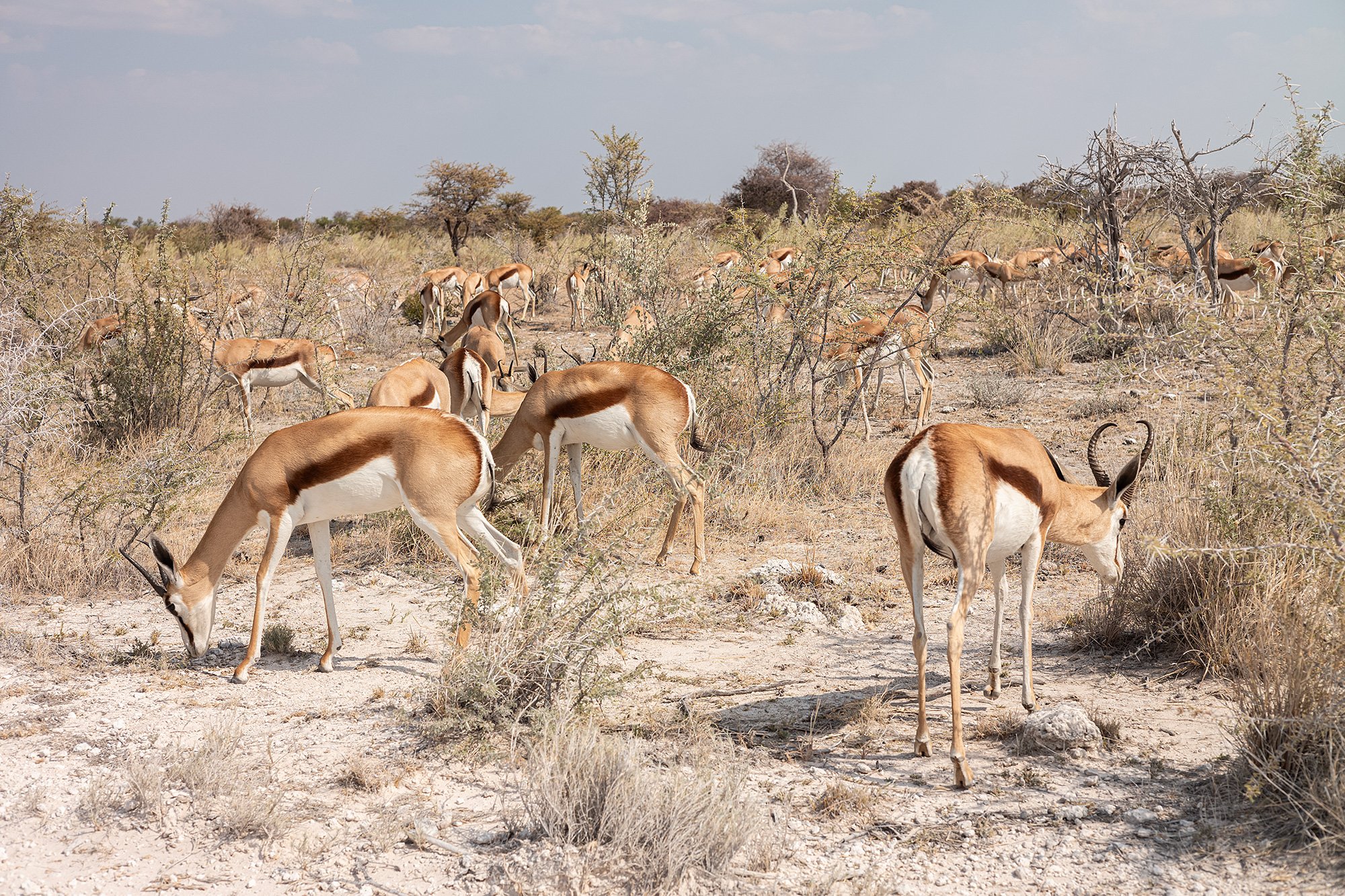

Near the Okerfontein waterhole I spot an elephant. A car had been following the elephant as it walked alongside the access road and I motion to them, asking if I can pull ahead. They nod and I drive ahead towards the waterhole, leaving the elephant behind. It soon catches up with me as I near the waterhole, and I stop to let it cross in front of me to reach it. Its child has gone ahead and soon I see them both splashing in the pool.
Off to the side, a single springbok stands by another pool. I wonder where its friends are.

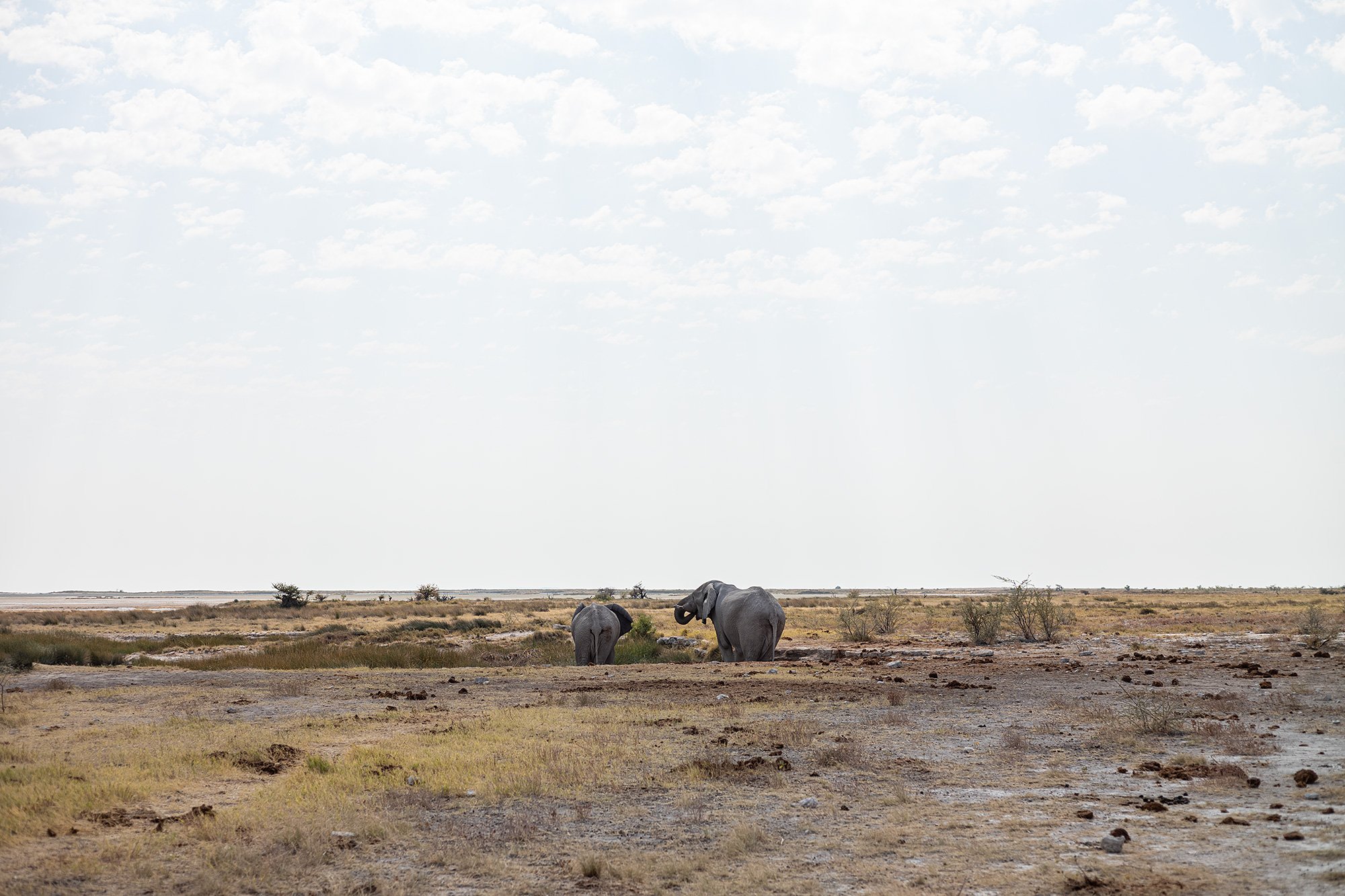

I continue driving towards the main road, spotting zebra, orxy, and springbok in the bush. It’s another 80 kilometers to the King Nehale Gate. The GPS tells me it’s 90 minutes if I drive direct. The afternoon stretches on.
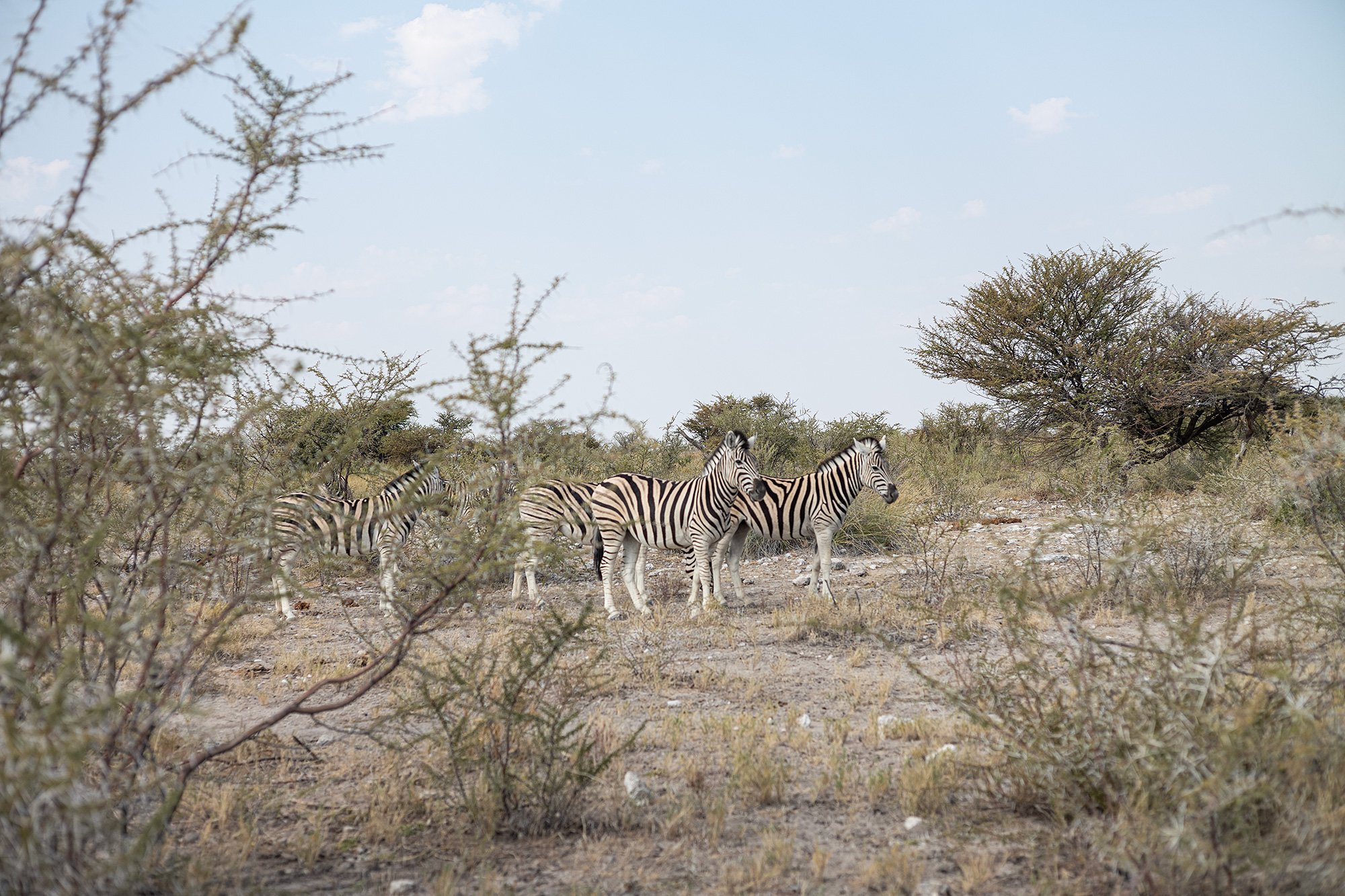

I take the exit for the Kalkheuwel waterhole. It’s one of the worst roads I’ve seen in the park. Nearing the waterhole I spot a few elephants walking next to me in the bush. I hurry ahead in hopes of catching them at the waterhole, but there’s no water. I’m curious as to how their trunks seemed wet. Turning around I drive back slowly in search of them but they’ve disappeared.
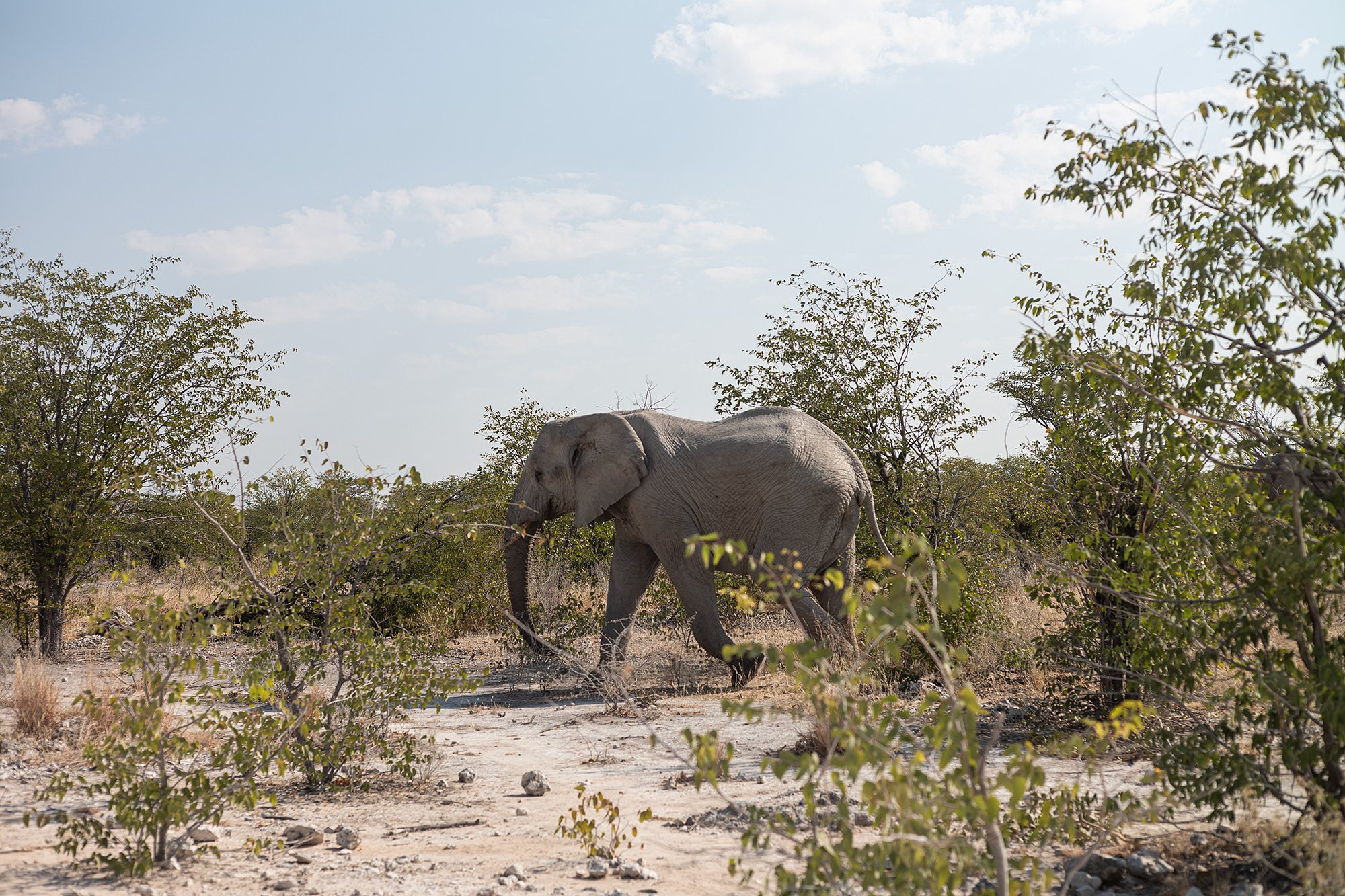
I continue on to the Koinachas waterhole where zebra, giraffe, and impala share the waterhole. I sit and watch the parade of animals for a minute before continuing on. I’m starting to become aware of the time so as to be able to make it out of the park. As I drive back to the main road, I spot a giraffe by the side of the road. I interrupt their meal and they look at me for a moment before loping off in search of another bush upon which to feed.


Near Namutoni camp, I stop by the King Nehale Lya Mpingana Warrior’s Memorial Monument. Unveiled in 2022, it commemorates the Battle of Amutuni LyoManengwe in 1904, when King Nehale’s warriors chose death over subjugation to German colonists. It’s a somber reminder of the past.
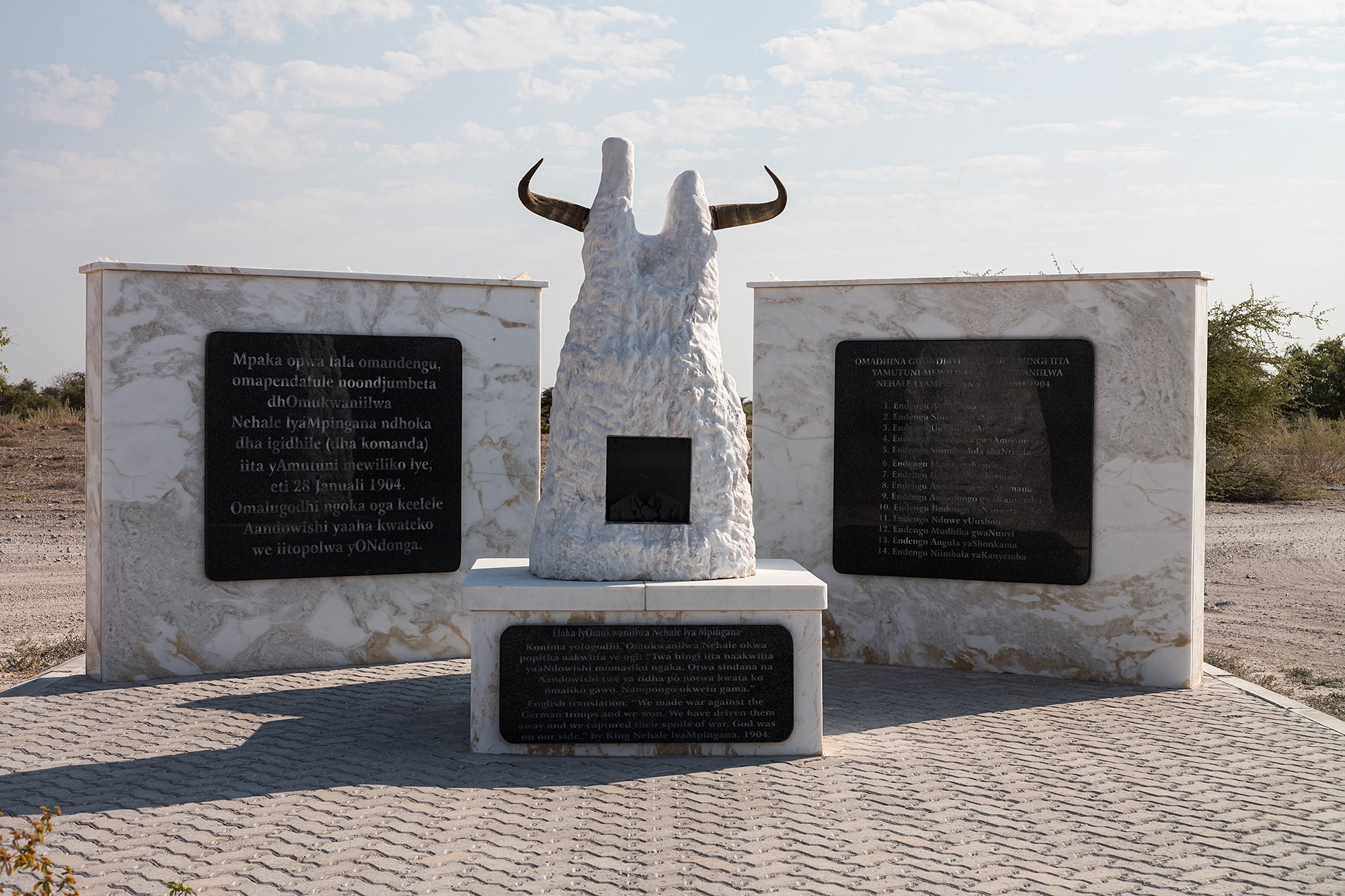
Turning north I head towards King Nehale Gate. The road runs through a small portion of the pan, dividing the Etosha Pan and the Fischer’s Pan before continuing north along the western edge of the Etosha Pan.
Wildebeest and zebra walk the edge of the pan, some zebra with child in tow, some pregnant.
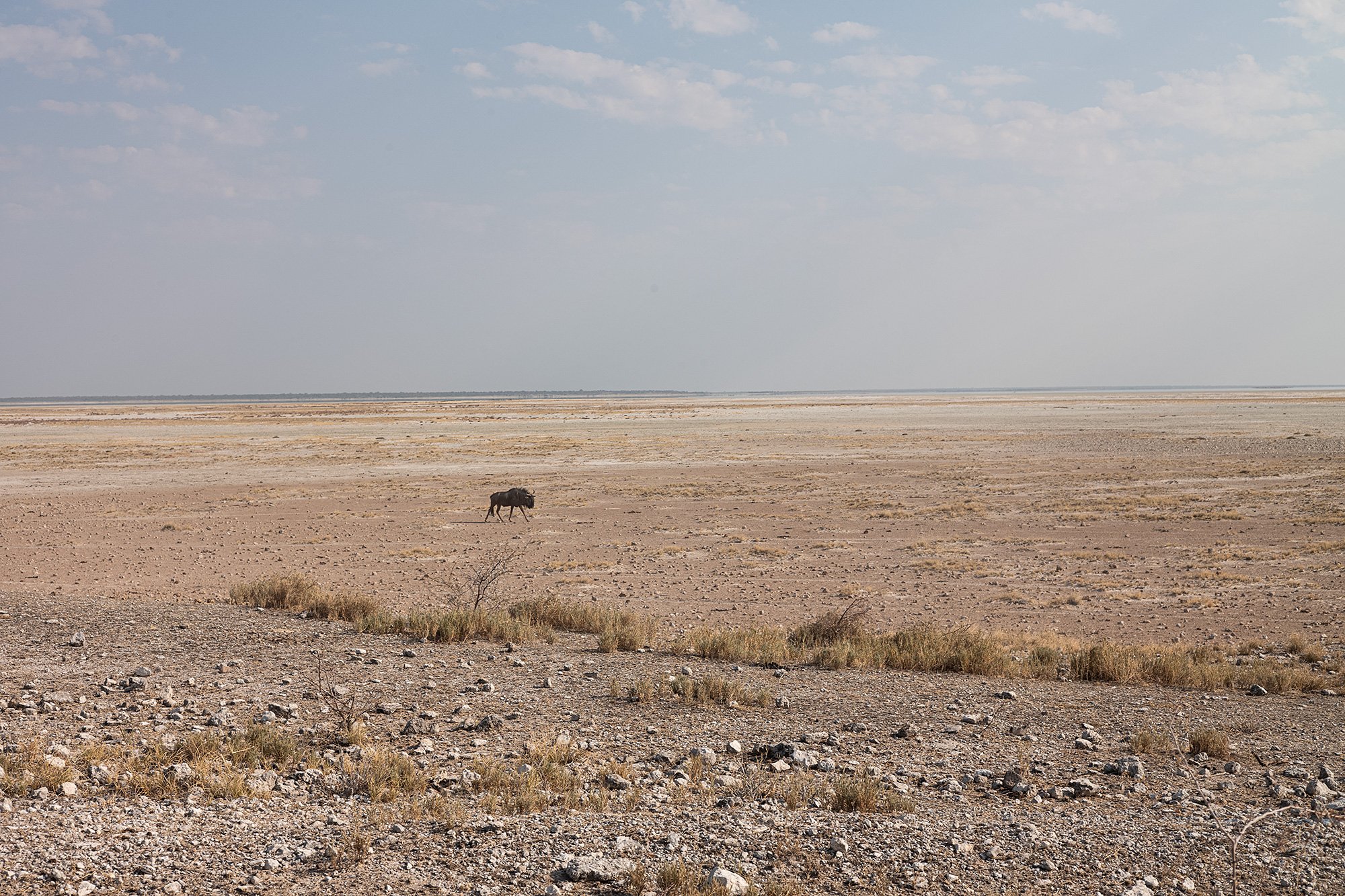
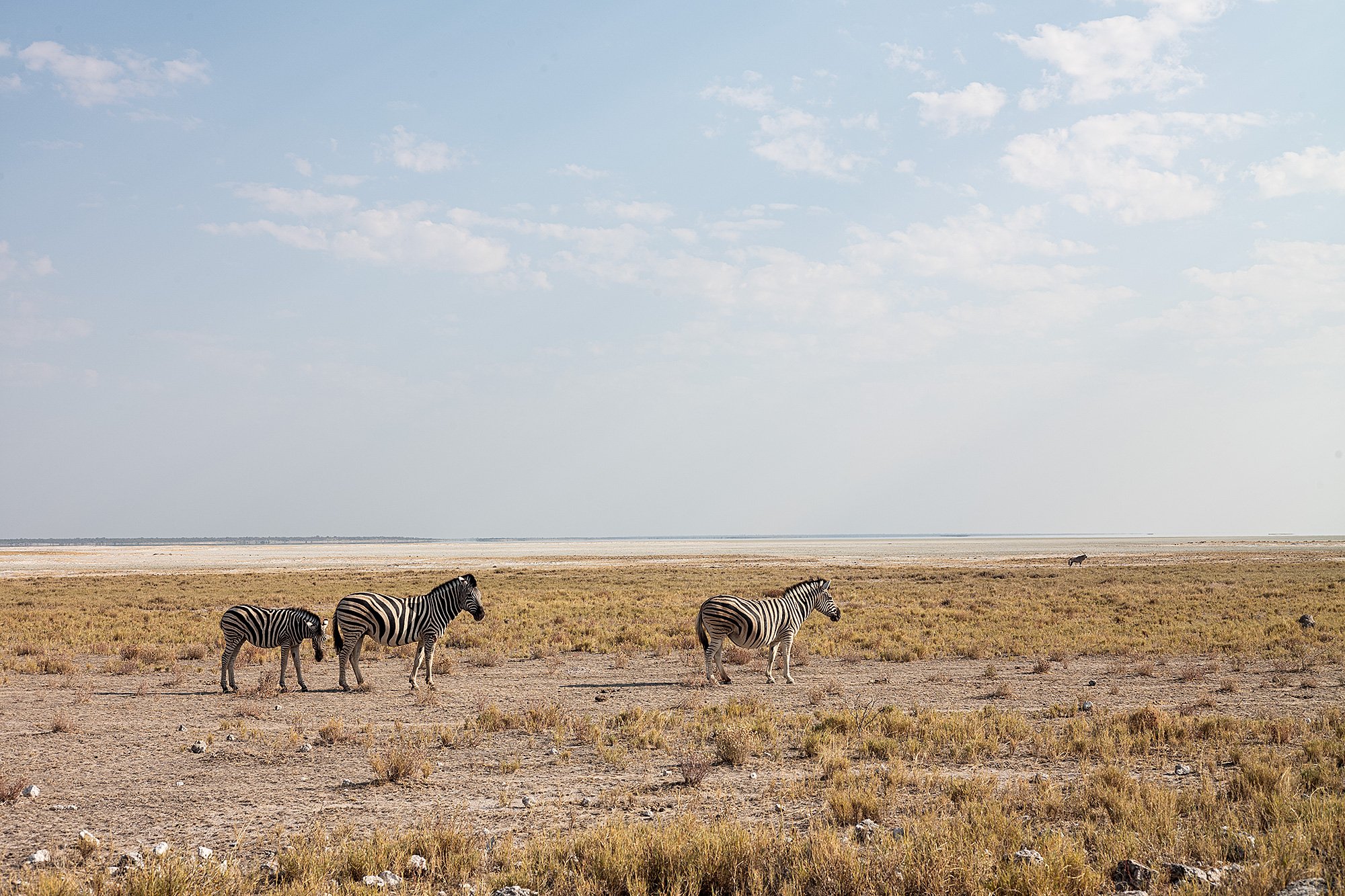

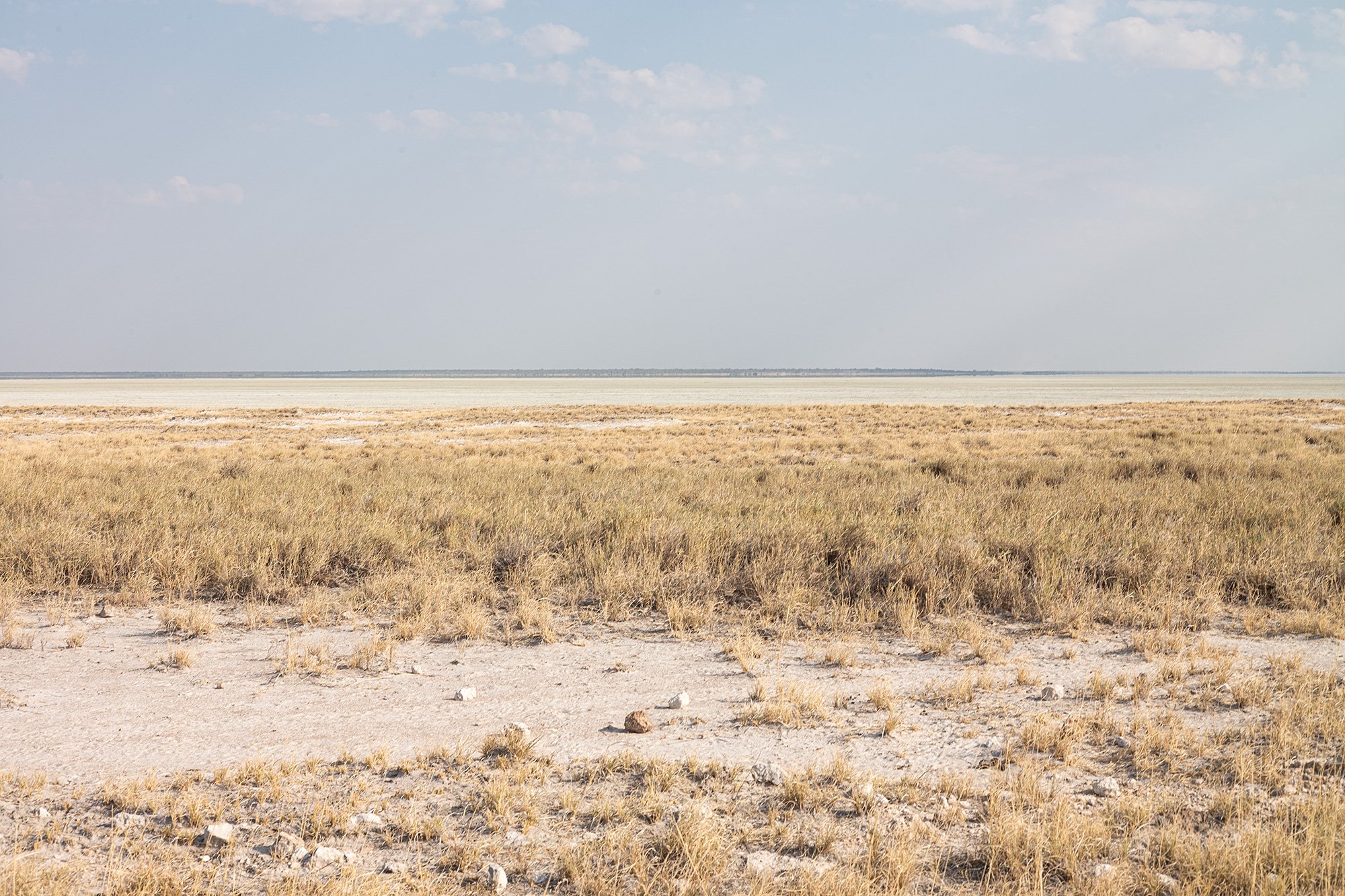
A large herd of elephants have commandeered the Tsumcor waterhole and I stop to watch as they splash around the pool. Giraffe stroll by, biding their time, while zebra content themselves to one side. It continues to amaze me, seeing all these animals coexist and interact with each other, reminding me of my status here as an outsider.
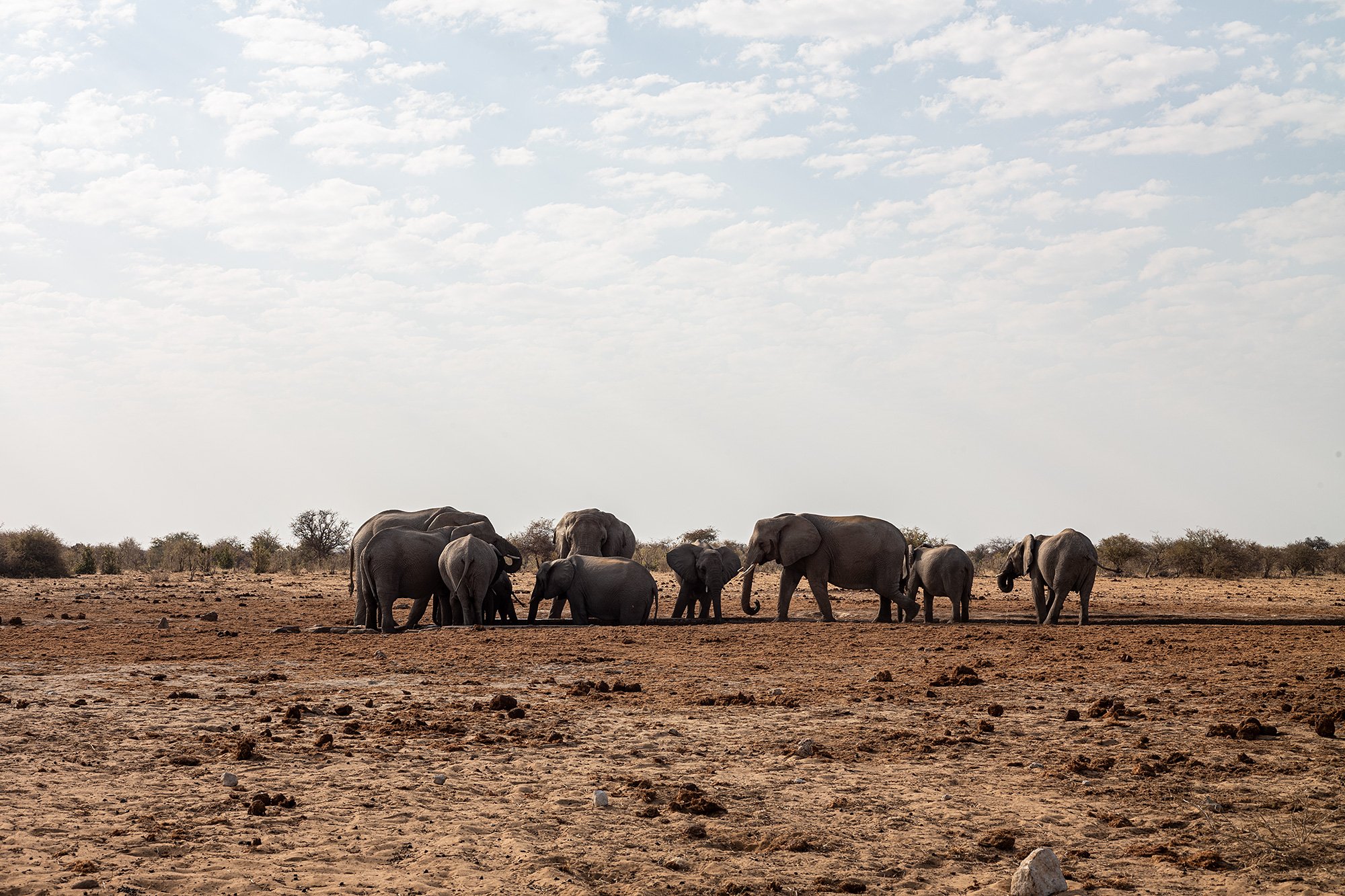


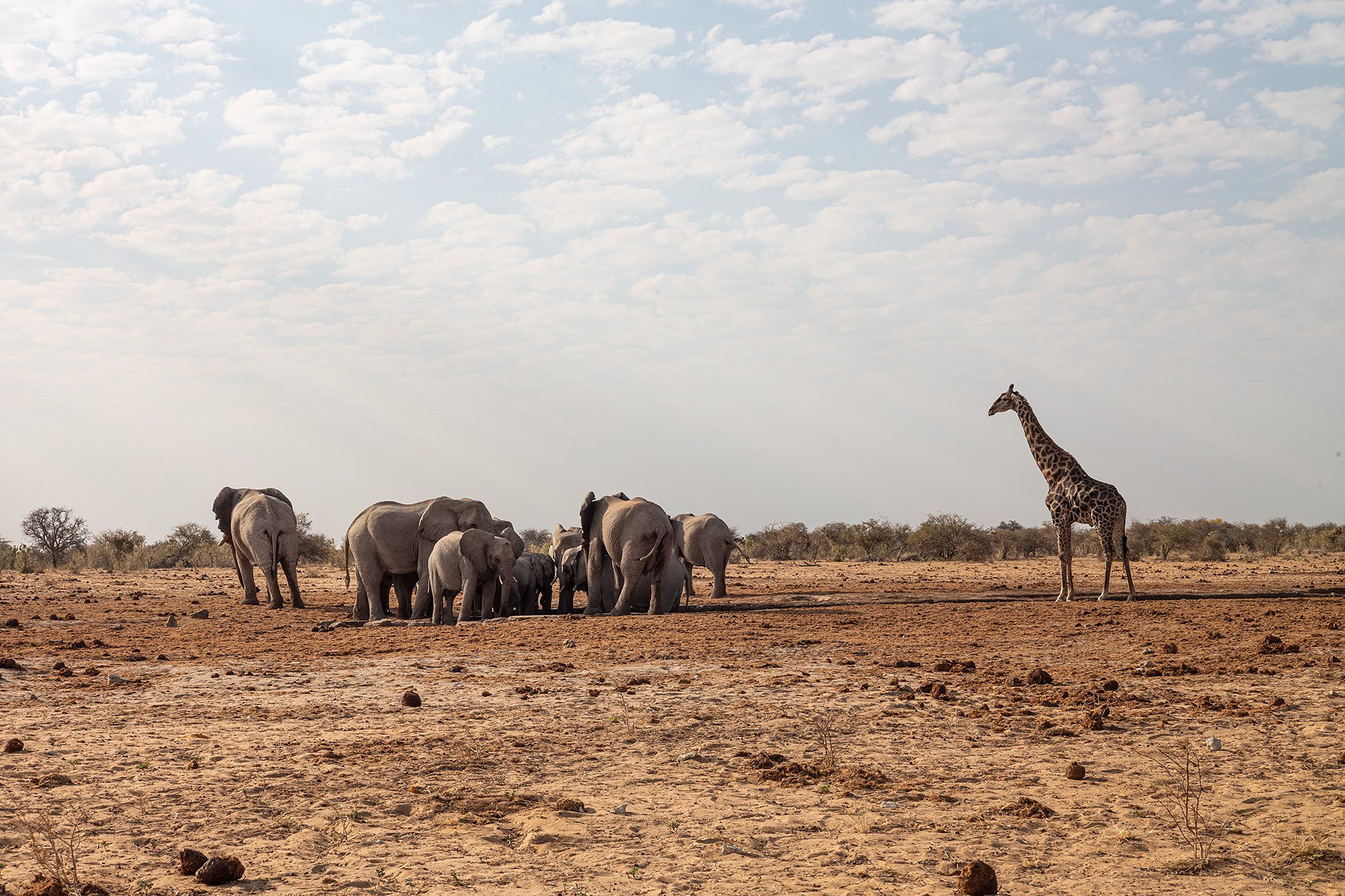
The day moves on, the sun shifts in the sky. I leave the waterhole, heavy of heart. There are only two more waterholes on the map between the gate and me and I imagine it’s the last I’ll see such a large herd of elephants before I exit the park.
I take a detour off the main road to drive closer to the pan and to visit the Stinkwater waterhole. The landscape continues to seduce my eye, the colors green and blue on the pan, the grass golden right before me.
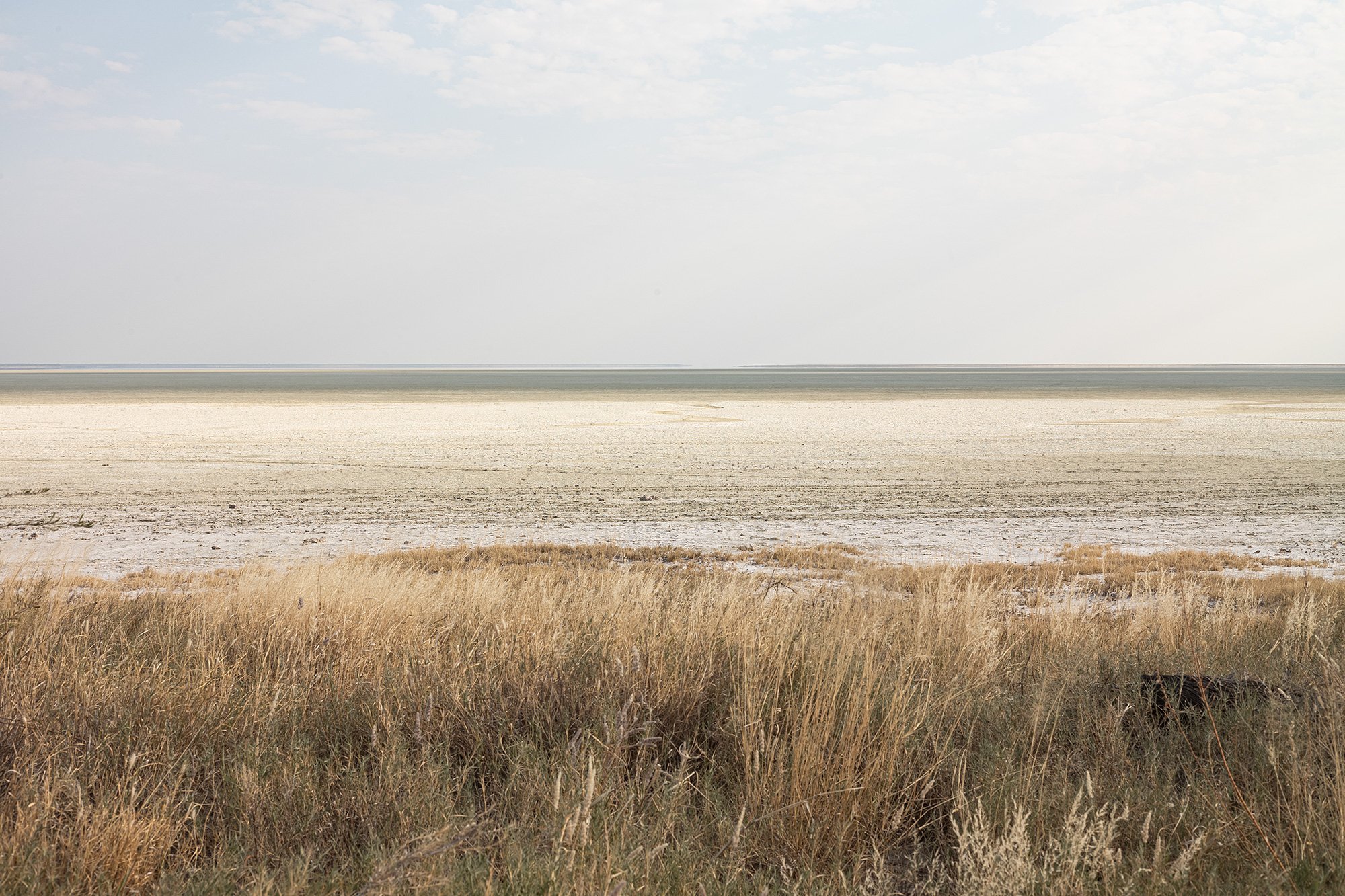
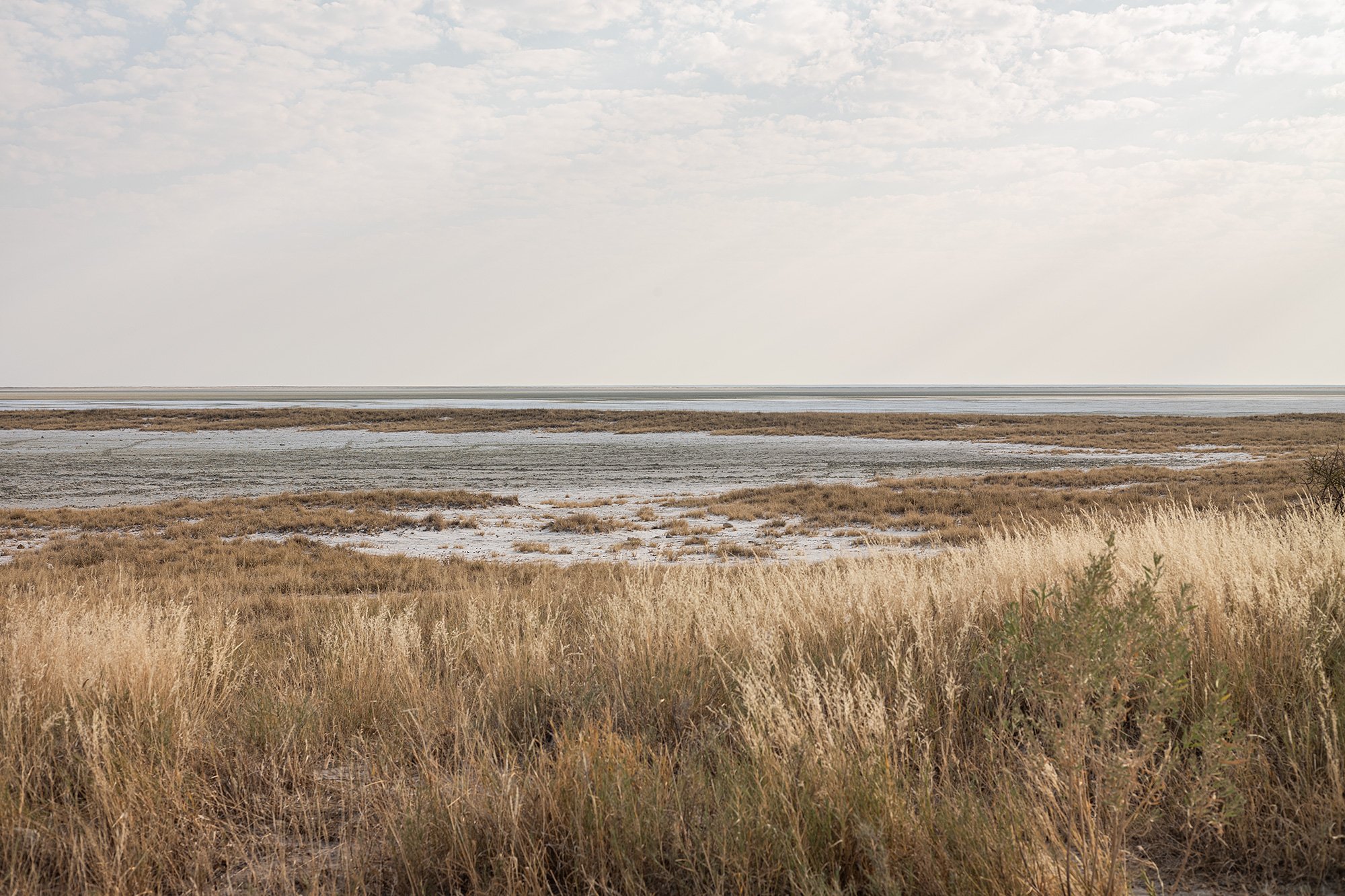

Stinkwater is dry. A lone springbok stands by the dry pool. Animal paths lead into the bush. I continue driving along the detour and see another sign for Stinkwater and take the turn to follow a road heading southwest towards the Onkoshi camp.
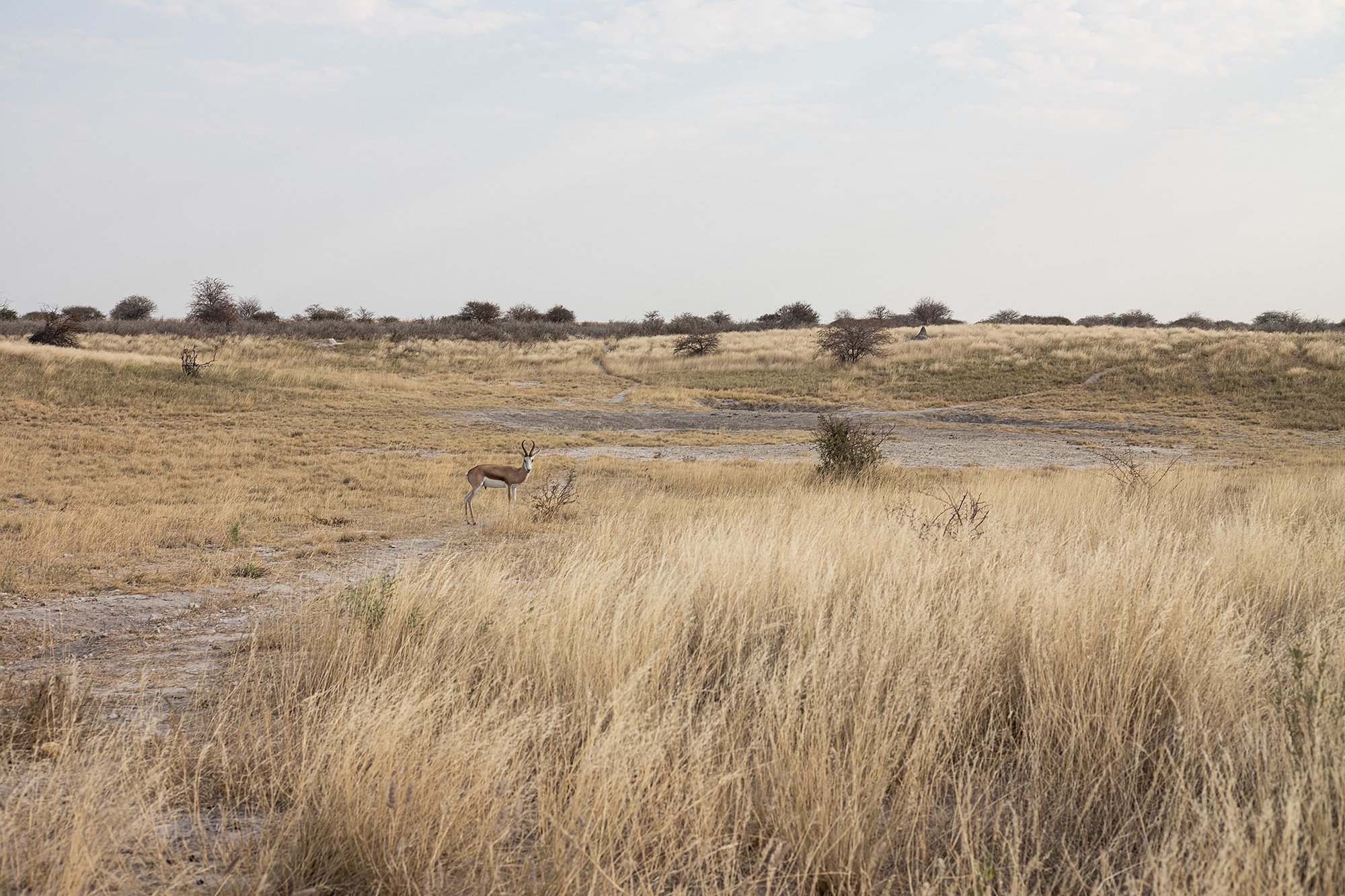
I drive a few kilometers without seeing another waterhole. Judging by my map, I’ve gone too far, and the GPS tells me that at my current pace, I’ll reach the gate at 1715, an hour before the park closes. I also want to get to the lodge before sunset to take a dip in the plunge pool and celebrate my trip around Namibia. It’s the last night of my journey and I want it to be as memorable as the trip itself.
I’m about to turn around when I pass a giraffe right by the side of the road, startling us both. I drive a bit further on before turning around to find it on the other side of the road, bathed in the golden late-afternoon light. Nearby, beautiful weaver’s nests glow in the selfsame light.
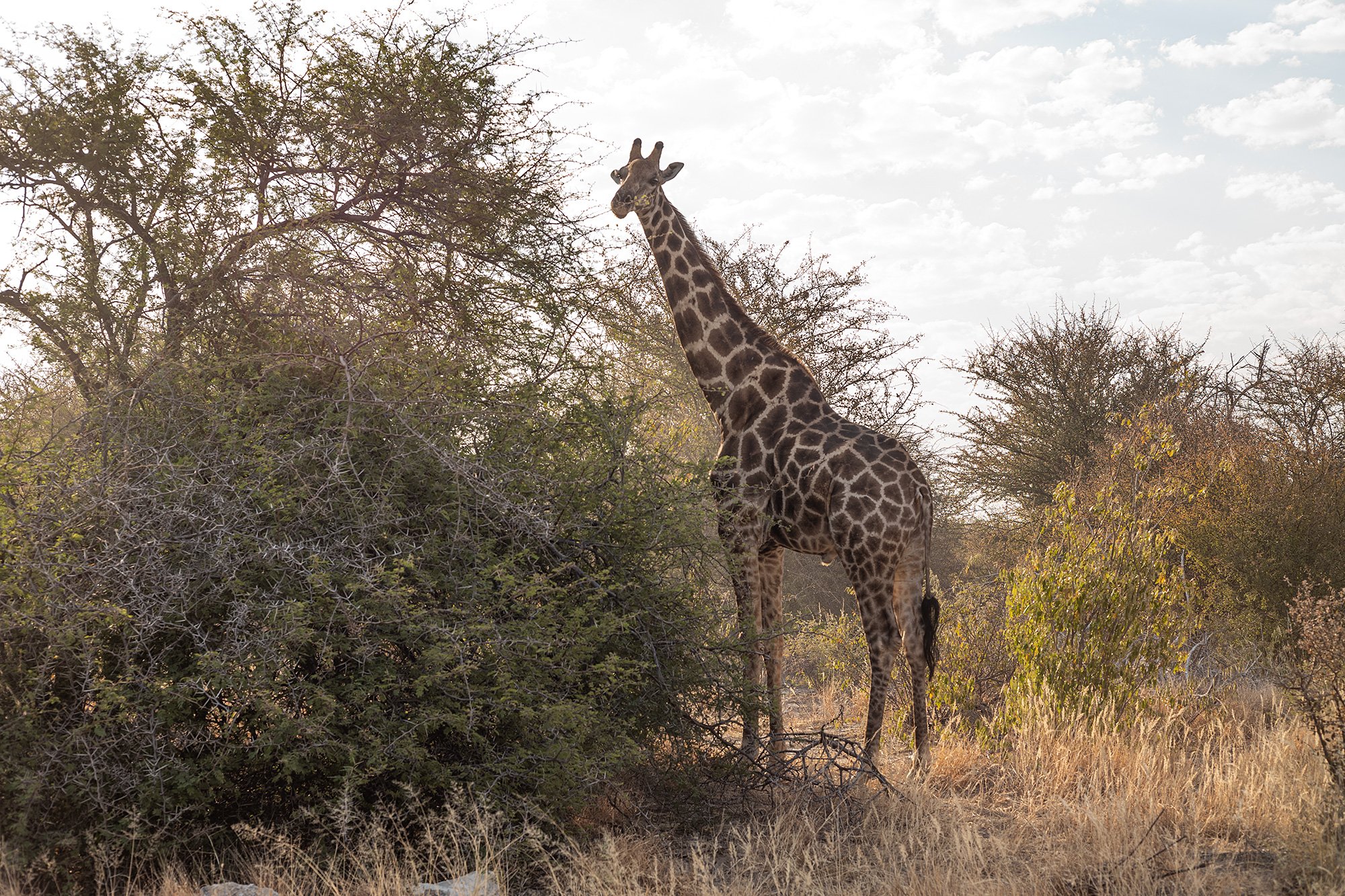
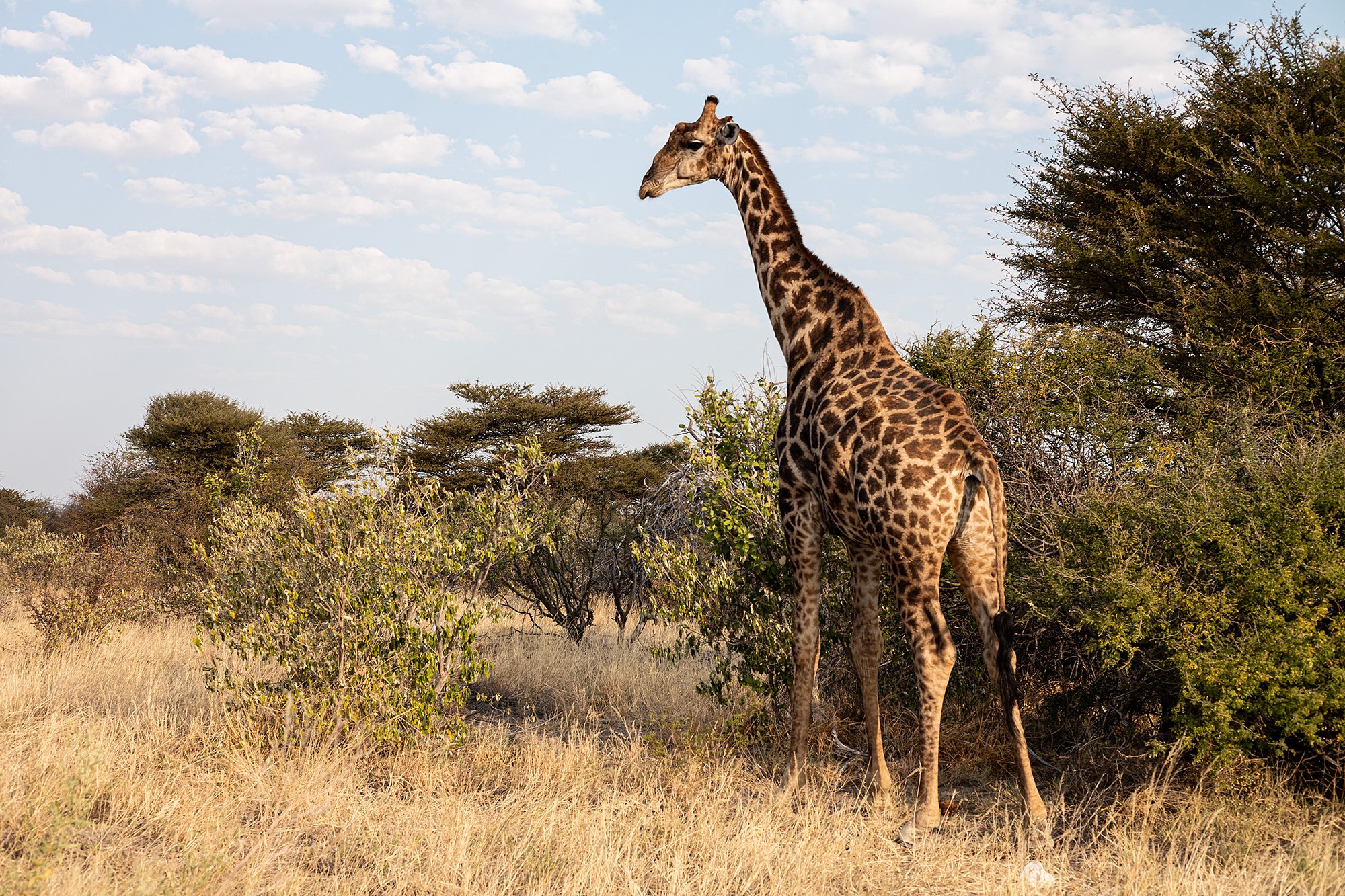

Nearing the gate I take one last detour to follow a looping road into the grassland and the Andoni waterhole. Zebra and wildebeest appear here and there as I drive the loop. And just as I’m about to complete it, I spot a kudu off in the distance. Beyond a jackal or two it’ll be the last animal I see.

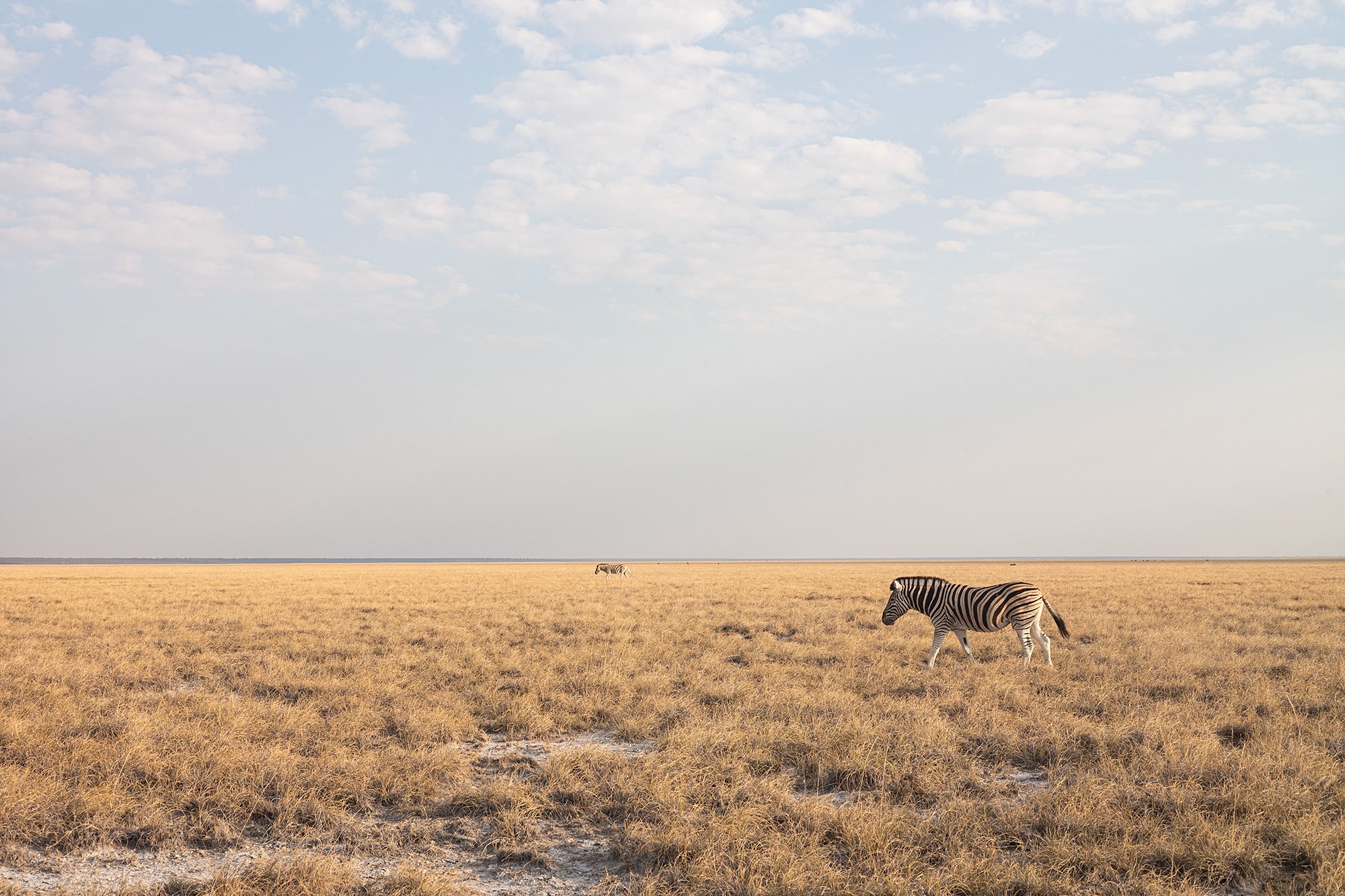

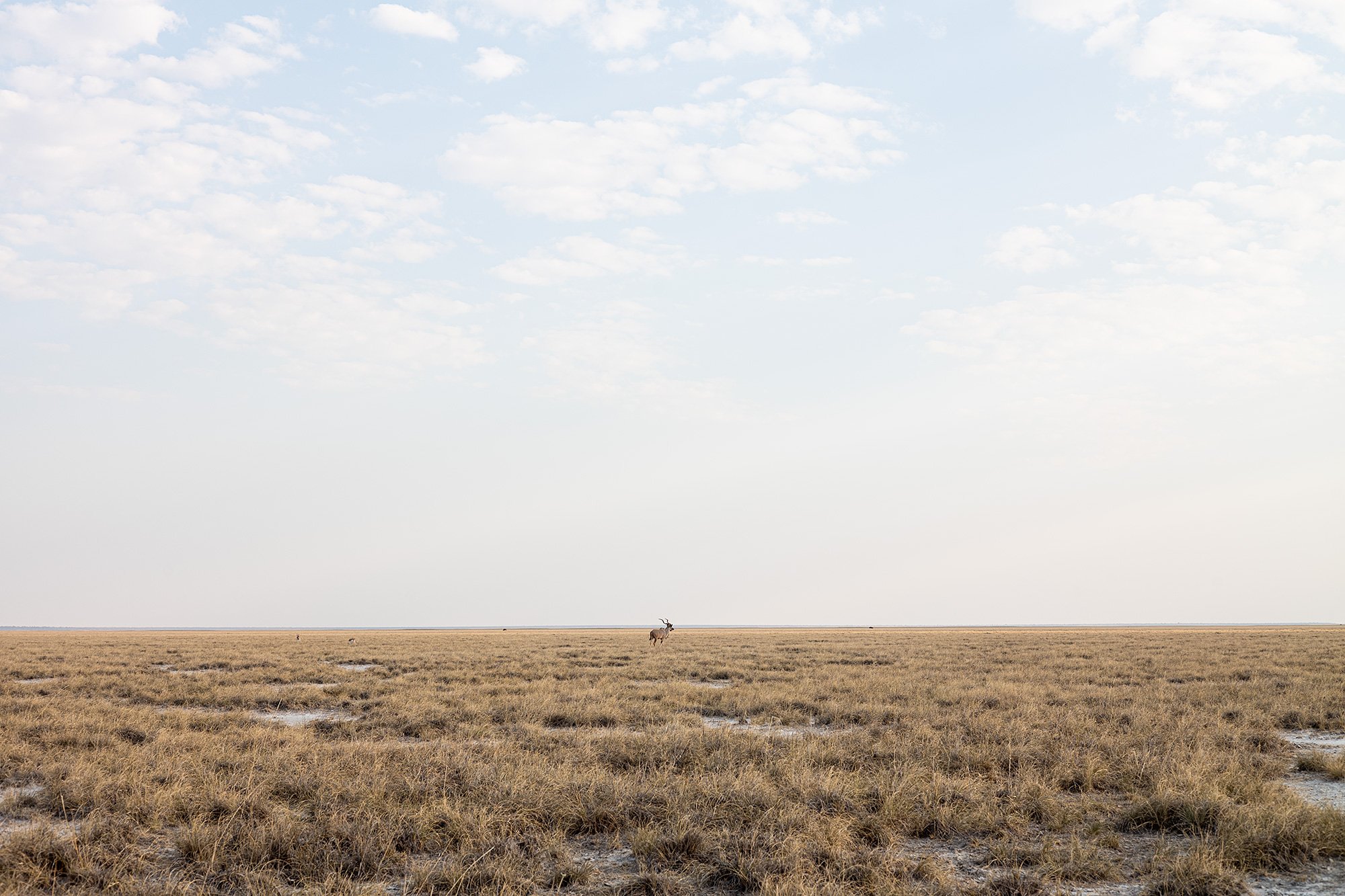
A long fence demarcates the edge of the park. A small gate at the end of the road allows passage through. I stop the car by a small office building and bring my paperwork to the front desk. They give it a cursory glance and wish me well on my journey.
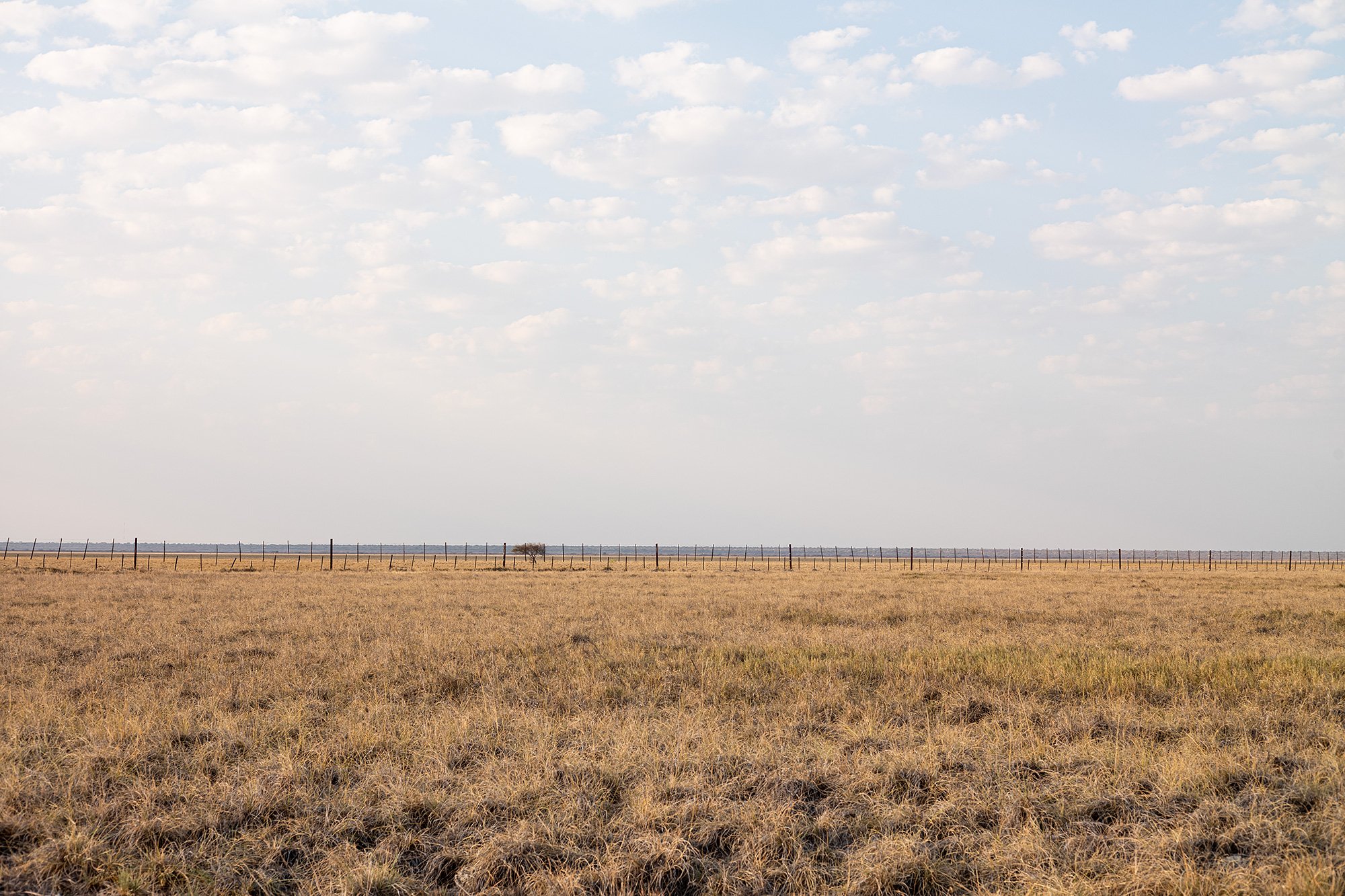
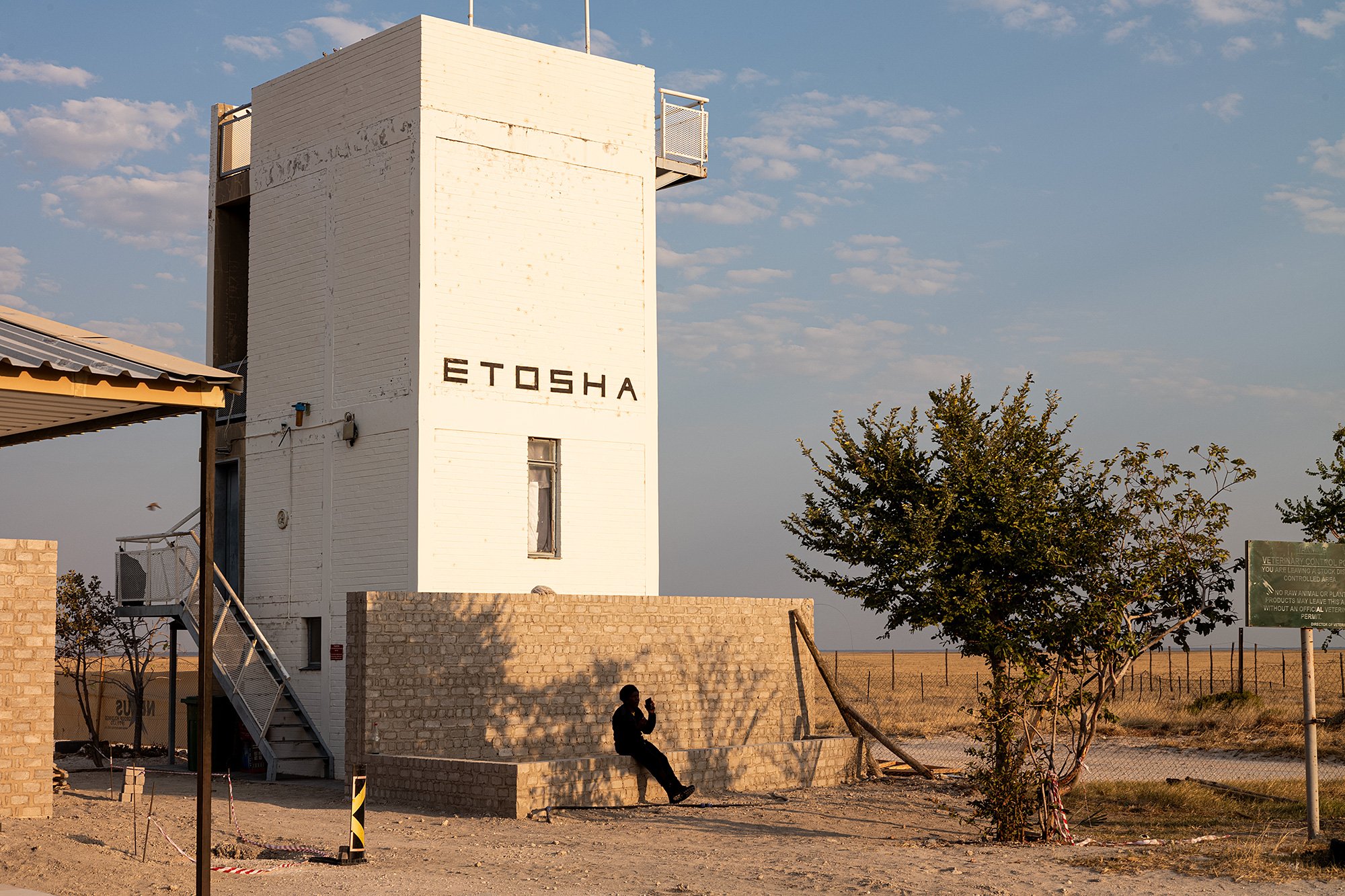
The Etosha King Nehale Lodge sits just outside the park. A wooden throne marks the turnoff. I take the exit and drive towards the line of cabins on the horizon.
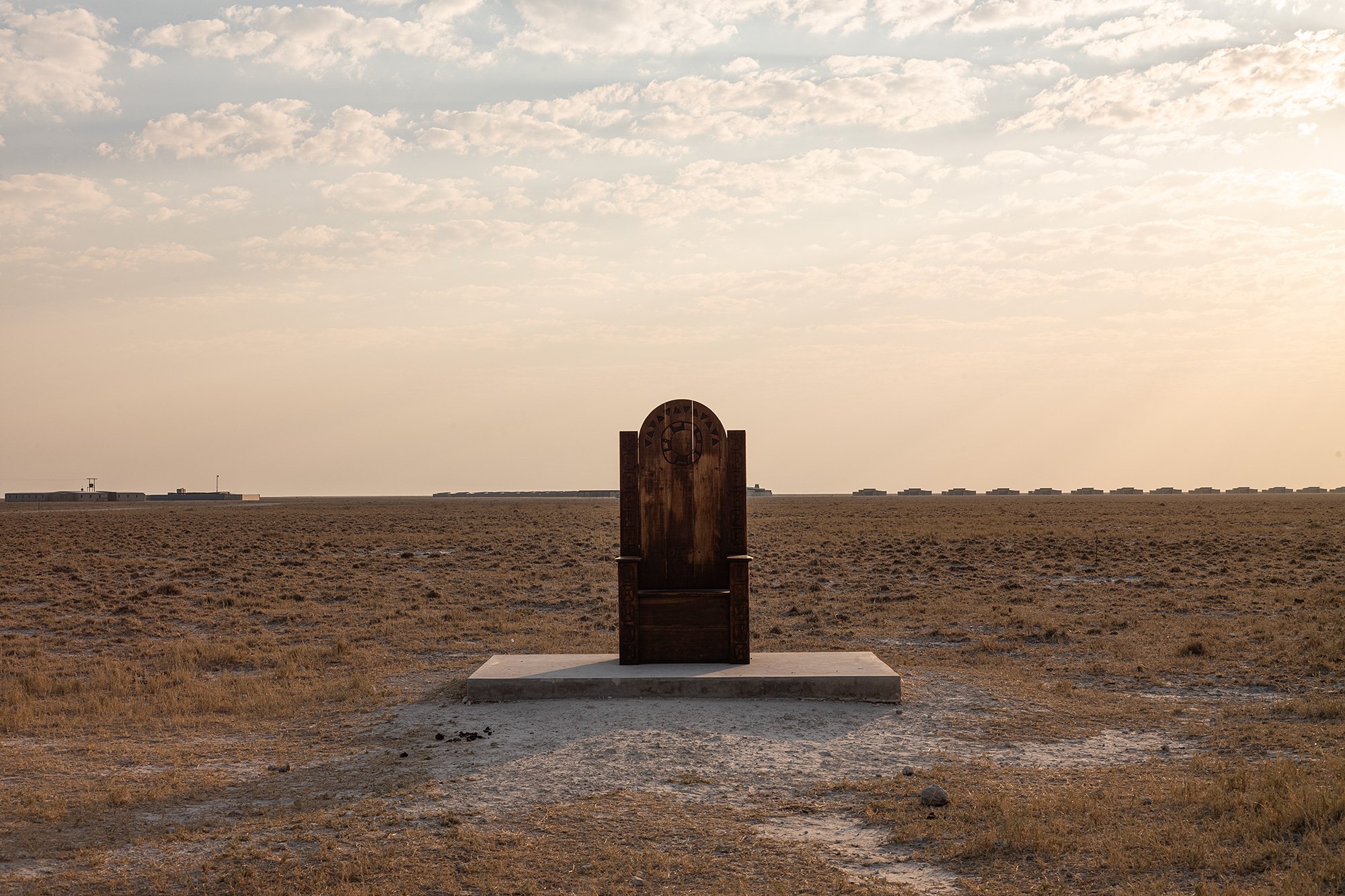
The lodge feels empty. It’s beautiful, if a bit sterile. I’m told there are a few guests this evening, but most of the cabins lay dormant. I’m shown the dining room, the firepit, and then my room, which is expansive and well-appointed. A fridge is stocked with wine and beer and a half bottle of Pierre Jourdan Belle Rose.
I change into my swim trunks, pop the bottle, and toast the end of my road trip with a dip in the cold plunge pool as the sun dips towards to the horizon.

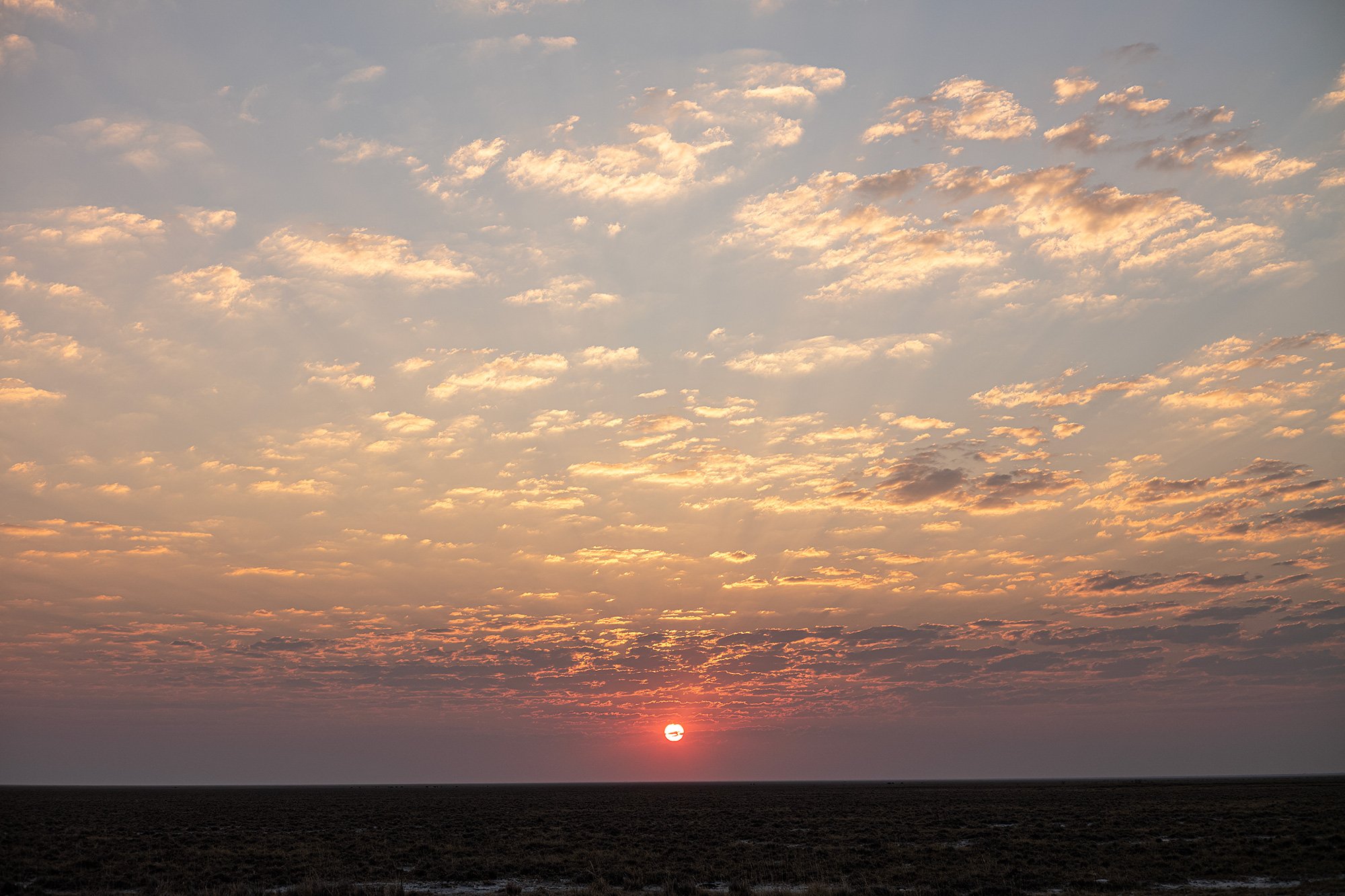
Tomorrow I’ll be driving south towards Windhoek. A few weeks ago I was driving south away from Windhoek towards Fish River Canyon, my first taste of the country outside of the capital. I couldn’t have imagined what an amazing trip it would be.
On my way to Windhoek I’ll be shaken down for money by a cop for not stopping completely at a stop sign (arguable) and for not having my lights on (true, though other officers have left me with a friendly reminder); I’ll lose my wallet.
At the traffic stop the cop will show me a list of moving violation fines printed in a booklet. He’ll tell me we can go to the station (though the town is many kilometers away) or settle things there. I ask him how much. He suggests a fee that’s a little less than half of the printed fine would be. He tells me to put the money in the book.
The transaction complete he will wish me a pleasant stay, ask me when I plan to return.
But none of that will spoil the enchantment I feel from the month I’ve spent in Namibia. It’s one of my favorite countries.

I recline on a lounge chair to watch the sun set. I finish the half bottle of sparkling wine. I’m a little wobbly when I stand up.
Dinner is served buffet style. Grubs are served both dried as a side ånd cooked. I love the dried grubs; they have a satisfying crunch.
Back in my cabin I prepare for bed. When I close my eyes I see the road ahead, animated. It stretches before me and behind me to the horizon. It feels boundless, endless, and I jump at the chance to continue my explorations. 🇳🇦
9 June 2024



